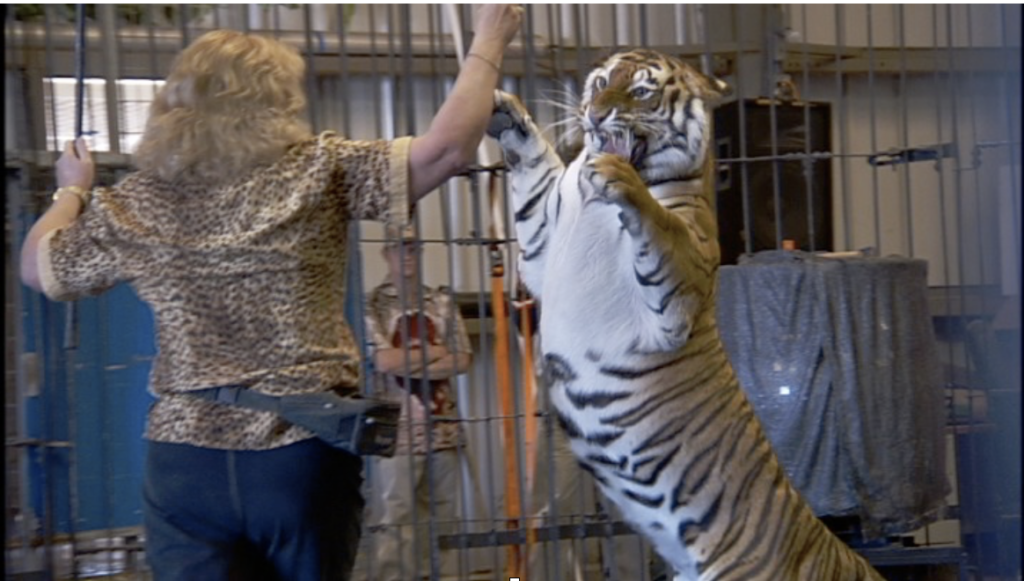
At a USDA Big Cat Symposium in Fort Worth, Texas on March 26, 2003, Kay Rosaire gave this advice on stage: “To keep a tiger off you, you just poke ’em real hard with a pitchfork a time or two and show ’em who’s boss. Then they’ll get the message.”
Big Cat Habitat and Gulf Coast Sanctuary is not a “sanctuary” at all, but a roadside zoo and circus show owned by the Rosaire-Zoppe family of circus animal trainers. As the public increasingly rejects the exploitation of wild animals for entertainment, the Rosaires are attempting to hold on to their way of life by “humanewashing” their 30 acre circus compound as an animal sanctuary, rebranding their on-site circus show as an “educational animal demonstration,” and duping the public into believing that their performing animals are “rescues.”
Kay Rosaire founded Big Cat Habitat in 1987 as a winter quarters and training compound for the family’s circus animals. It remains the main facility where big cat trainers Kay and Clayton, chimpanzee trainer Pam, and bear trainer Frederick Rosaire house the performing animals which they continue to exploit for profit at shrine circuses, fairs, and film shoots across the country. The Rosaires have gone through multiple USDA licenses and have racked up over 50 combined pages of federal Animal Welfare Act violations since 1997.
As a result of the family’s dominance-based training methods and barren confinement at the “sanctuary,” wildlife experts and federal inspectors have observed many of the animals at Big Cat Habitat displaying signs of “severe psychological distress” such as pacing, self-mutilation, deliberately regurgitating and reingesting their vomit, and urinating in fear during performances.
As of 2018, Big Cat Habitat is home to 150 animals, including 50 exotic cats (lions, tigers, leopards, cougars, servals, bobcats, and a liger and tigon). The GFAS-accredited Chimp Sanctuary Northwest warns that “the animal attraction claims to be a reserve for animals, but they regularly exploit their residents for entertainment purposes. In fact, the Rosaire-Zoppe family are the only remaining trainers that continue to use chimpanzees in circuses. No respectable reserve or animal sanctuary would lease out their animals for media productions.”
In an interview with Circus World Museum, Kay and Pam Rosaire admit that Big Cat Habitat was founded to provide a venue for the family’s animal acts:
“The habitat in Sarasota that I started with my dad, about 25 years ago, we wanted people to come in and watch us train. Then we had rescued a bunch of animals and we wanted people to come in and see them… …People really have a thirst to see good animal acts and there’s nothing wrong with it.”
Unlike a true sanctuary, Big Cat Habitat openly advocates for the private ownership of big cats and primates, speaks out against animal welfare organizations during each show, and fights against legislation like the Big Cat Public Safety Act which would protect big cats from abuse and abandonment. They are also staunch supporters of the Outdoor Amusement Business Association, a circus trade group “which raises money and awareness to keep animals in the circus.”
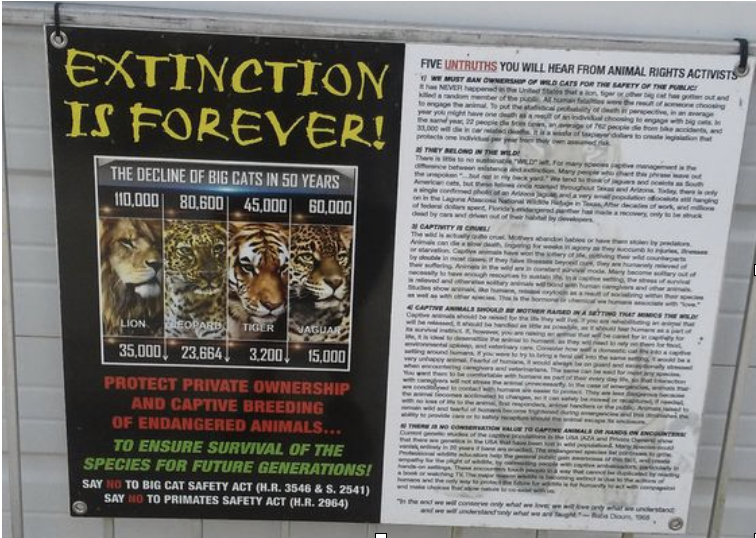
This sign, prominently posted at Big Cat Habitat, advocates for the private ownership and exploitation of big cats and rejects what they call “untruths from animal rights activists”.
The text on the sign claims that “pet” tigers pose little danger to the public and that ownership should remain legal, that big cats don’t “belong in the wild,” that cubs should not be raised by their own mothers in a natural setting because “they should be raised for the life they will live,” and that cub-petting and private breeding helps conservation efforts. Legitimate big cat sanctuaries and welfare groups are trying to fight against these ideas, but Big Cat Habitat actively promotes them.
A Tradition of What Many Animal Advocacy Groups Believe is Exploitation
This video by VICE is very informative and explains the Rosaire family’s long circus history and their mission to preserve animal circus acts at Big Cat Habitat.
Animal Welfare Act Violations & Incidents
Federal USDA inspectors have documented over 50 pages of Animal Welfare Act violations by members of the Rosaire family housing and exhibiting animals at Big Cat Habitat. These violations include:
May 23, 1997: According to The Chattanooga Free Press, UniverSoul circus employee Ted McRae was bitten on the shoulder during a training session by one of Kay Rosaire’s 400-pound tigers, causing a 2-inch gash. McRae was formerly a forklift driver and received only one month of training before working with Rosaire’s big cats at the circus.
February 10, 1999: The USDA cited Kay Rosaire, then exhibiting big cats with the UniverSoul Circus, for failure to provide a program of veterinary care. The inspector also noted that Rosaire’s newly acquired lion cubs were in “poor condition”, had not received veterinary care, and that their cages did not meet new size requirements mandating that animals have enough space to stand up and turn around in. View the inspection report
June 20, 2003: Kay Rosaire was cited for walking 2 young tigers on a leash instead of shifting them safely through a chute. An outdoor enclosure for tigers and lions lacked shelter from the elements. View the inspection report
June 2, 2004: A transport trailer for the big cats had 2 broken windows and a hole in the side panel. View the inspection report
November 6, 2004: A trainer was bitten by a bear at Big Cat Habitat and flown to the hospital to be treated for injuries.
December 7, 2004: Pam Rosaire was cited for housing chimpanzees in barren, undersized travel trailers with little light, no enrichment, and no furniture. The inspector noted that “the female chimps stereotypically regurgitate and re-ingest food, and extensively finger-paint with their feces. I observed Sabu, the 9 year old male, perform stereotypic head-shaking and self-slapping while in his cage. These behaviors are well-documented in professional literature among captive chimpanzees and indicate a need for additional enrichment.”

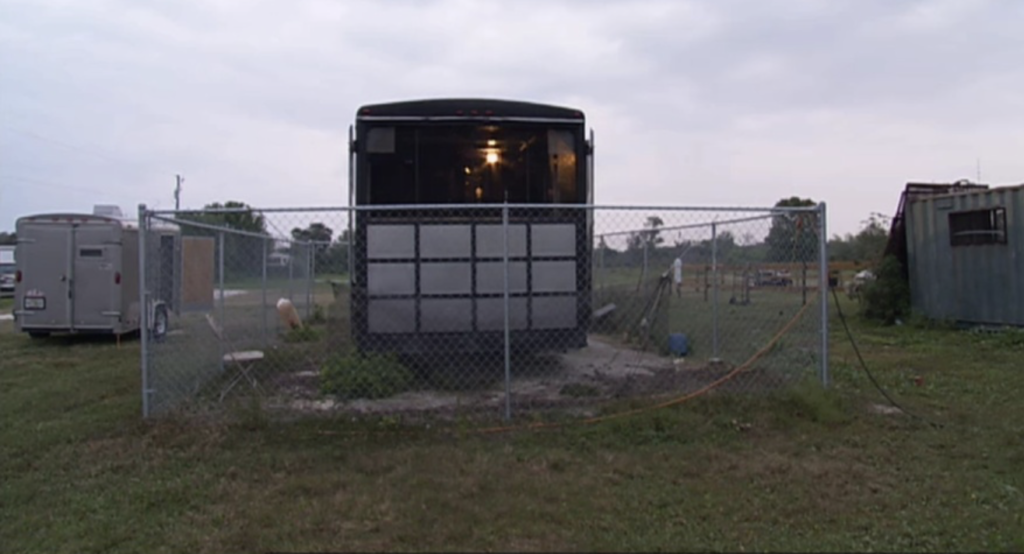
Pam Rosaire continues to house chimps in trailers on the Big Cat Habitat compound.
During this inspection, “the licensee confirmed that at a recent public exhibition, during a television interview, a child in the audience was able to come up unexpectedly from behind the handler, and be contacted by Ricky, a five year old male chimp.” On November 26, 2004, an ambulance was called to the Hadi Shrine Circus in Evansville, Indiana after a boy was bitten on the cheek by the chimpanzee. The boy was taken to the hospital and treated for a puncture wound. The inspector continued; “ [a trainer] demonstrated at this inspection that the chimps are handled with a small diameter rope noose around the neck, with the long free end as a leash. The rope functions as [a] choke-type collar, in that it tightens if the handler end is jerked. This method cannot control a chimp without risk of harm either to the chimp or the public.” View the inspection report
Jun 23, 2005: Kay Rosaire was unable to provide acquisition records for her big cats at this inspection. View the inspection report
August 29, 2005: The fencing around Pam Rosaire’s fairground chimpanzee show was held together by duct tape and not structurally sound. Rosaire was cited a second time for continuing to use an unsafe rope “noose” to control a performing chimpanzee and for continuing to house chimpanzees in undersized enclosures which lacked any enrichment or perches. The cages holding the chimps were less than three times the size of the animals inside. The inspector wrote that “this situation has been cited before on a previous inspection and it does not appear that any corrections have been made. This situation of housing and enrichment needs to be addressed for the mental health and well-being of these animals.” View the inspection report
June 22, 2006: The perimeter fence for the lion and tiger area at Big Cat Habitat was not in compliance, and a door used as a chute to transfer the big cats was not attached to the building. The refrigerator containing the food for the big cats contained 50 boxes of rotten chicken with a foul odor. “The cooler smelled of rotten chicken and ammonia and had old blood and drippings from the thawed chicken on the floor.” The inspector noted that “the large felids written diet includes beef and vitamin supplements which need to be available and fed as recommended by the facility’s attending veterinarian.” Big Cat Habitat was unable to provide documentation on where food was obtained, dates of purchase, thawing, and freeze methods. During this inspection the chicken in the cooler was thrown out. View the inspection report
March 6, 2007: Kay and Derrick Rosaire were cited for failing to provide bears with adequate shade and shelter from the elements. There were accumulations of trash behind the bear enclosures, and feces and food waste were hosed into an area which “is not draining and smells of extremely foul odors of old excreta and food.” View the inspection report
May 14, 2007: Big Cat Habitat was cited for holding a tiger and lion show in a ring which lacked a perimeter fence. The inspector also observed “numerous travel/transport enclosures housed with tigers and lions in the training/show building without a perimeter fence,” and that one section of the perimeter fence around the building was not secured. View the inspection report
May 16, 2007: Kay and Derrick Rosaire were cited for housing two adult bears in 7 by 7 foot enclosures where they were “unable to remove themselves from their own excreta to remain clean and dry.” The inspector observed the bears sitting in their own urine on the concrete floor and noted that the bears and their enclosures were wet most of the time due to the bears knocking over their water in the confined space. View the inspection report
March 28, 2006: Kay and Derrick Rosaire were cited for exhibiting two bears at a shrine circus with “no barrier to the public sitting at ring level” and no handler in direct control of the bears. View the inspection report
September 11, 2007: A USDA inspector explained to the Rosaires that their personal exotic pets cannot legally be exhibited to the public without being added to the facility’s license. View the inspection report
April 3, 2008: Acquisition records for the Rosaire’s primates were not available for inspectors to review, and the primates lacked a written environment enhancement plan. View the inspection report
April 10, 2008: Two Himalayan bears were being housed in a 7 by 7 foot enclosure which did not provide adequate freedom of movement and forced them to sit in their own waste. The inspector wrote, “For the health and welfare of these animals, all bears must be able to have sufficient living space at all times.” View the inspection report
April 22, 2009: The Rosaires were cited a third time for housing two bears in a 7 by 7 foot chain link enclosure with no room for the bears to remove themselves from their own excreta. These bears were “not able to be let out in their exercise area due to being incompatible with other bears” and had no access to a pool to keep cool when needed.
The freezer containing food for the bears had insufficient lighting and a broken thermostat.
Incompatible bears were only separated by strands of hot wire 18” apart. Because the bears could injure each other through the wire or get their body parts caught in it, the fencing was not structurally sound to protect the animals from injury. View the inspection report
October 13, 2009: A juvenile brown bear was held in a small cage which measured just 29” by 44” at a fair in North Carolina. The bear was about as long as the length of the cage and could not easily turn around. View the inspection report
July 26, 2010: During a prelicense inspection of the “Rosaire’s Bears” compound in Myakka City, an inspector noted that the primary enclosure for the bears was a steel shipping container with attached outside pens. The shipping container had rusted areas on the roof and loose paint flakes hanging from the entire ceiling. A baby bear was being housed in a travel enclosure until a permanent enclosure could be completed. The perimeter fence around the bear enclosures was surrounded by trash and building materials, and could easily be lifted up so that animals or persons could enter or exit the enclosure. View the inspection report
November 1, 2011: The Rosaires apply for a new license for Big Cat Habitat. During the prelicense inspection, inspectors note that a new adult white tiger’s enclosure lacks an incline at the top of the fence, and that the wood steps in another tiger enclosure had rotted areas. View the inspection report
April 4, 2012: The Rosaire’s Bears compound was cited for housing a two year old bear named Chief in a 12 by 7 foot travel enclosure which did not enable him to walk more than a few feet. Bears were observed drinking water which was brown in color and smelled strongly of old urine and feces. The inspector wrote that “the licensee stated the trough is emptied and refilled every few days. However, with the odor coming from this trough, it was not emptied in the last few days.”
Enclosure fencing was “mangled” in some areas and had pointed areas which could harm the bears, and the perimeter fence was loose and leaning.
The bear training enclosure had an open top, no perimeter fence, and was not secured to the ground to ensure that it would contain the bears. There was also “an accumulation of bags of household trash” and high weeds near the bear enclosures. View the inspection report
July 11, 2012: Rosaire’s Bears was cited for housing 5 bears in a concrete-floored steel shipping container with “excessive rust” and inadequate cooling for 115 degree summer temperatures. 3 of the 5 bears were housed in an 8X10’ shipping container with no watering trough and not enough space to “allow the bears adequate freedom of movement or keep them from being in their own excreta.” Inspectors noted that the a mister caused the entire concrete surface where the bears are housed to be wet at all times and that the enclosure was surrounded by multiple areas of stagnant, algae-filled water several inches deep.
A water trough for the bears was full of dirty brown water. The inspector writes: “The two male licensees stated it was emptied and refilled today, however, I observed a state wildlife officer fill his shovel with dirt from the bottom of the trough.”
The Rosaires were cited a second time for continuing to house a two-year old bear named Chief in an 8’X10’ trailer even after being informed in a previous inspection that the enclosure “does not allow him the opportunity to walk more than a few feet or keep him from his own excreta.” The facility also received a “repeat noncompliance” for failing to correct sagging perimeter around the bear enclosures, and for having a “training and exercise arena” for the bears with no perimeter fence at all. Bear enclosures continued to be surrounded by “an accumulation of household trash, animal fencing, high weeds and other trash.” View the inspection report
November 15, 2012: A 9 year old brown bear named Chopper attacked and killed a 3 year old bear named Chief. An inspector reported that Chopper was able to dig underneath the wire fence separating the bears because a portion of it was not secured to the ground in violation of USDA regulations. Chopper then attacked Chief, fatally puncturing his lung. View the inspection report
April 22, 2016: A USDA inspector at the Aleppo Shriners Circus in Wilmington, Massachusetts found that the main source of food for two of the Rosaires’ adult brown bears was “a large amount of bread.” The inspector noted that bread does not meet the nutritional requirements of adult brown bears. The inspector wrote in her report, “The licensee corrected this item at the time of inspection by going to store and bringing back a large amount of fresh fruits and vegetables.” View the inspection report
The Truth about Big Cat Habitat’s “Rescues”
Although Big Cat Habitat pulls on the public’s heartstrings by claiming that their animals were rescued from being euthanized, many of them were purchased for use as performers or “transferred” from other private breeders, often as cubs. Legitimate sanctuaries never buy, sell, breed, or trade animals, and young cubs are rarely in need of rescue because they are still small enough to be exploited for profit. Some animals, particularly the birds, may be legitimate rescues, but it’s impossible to confirm this because the Rosaires provide no evidence.
This sign posted at Big Cat Habitat admits that many of their “rescued” animals “did not come from a situation of abuse or neglect,” but are the private pets of the Rosaires, performing animals who are exploited to raise money for the facility, or are still owned and cared for by private owners who could no longer keep them on their own property. This raises concerns that people who have been barred from owning exotic animals may be continuing to do so by “hiding” under the Rosaire’s permits.
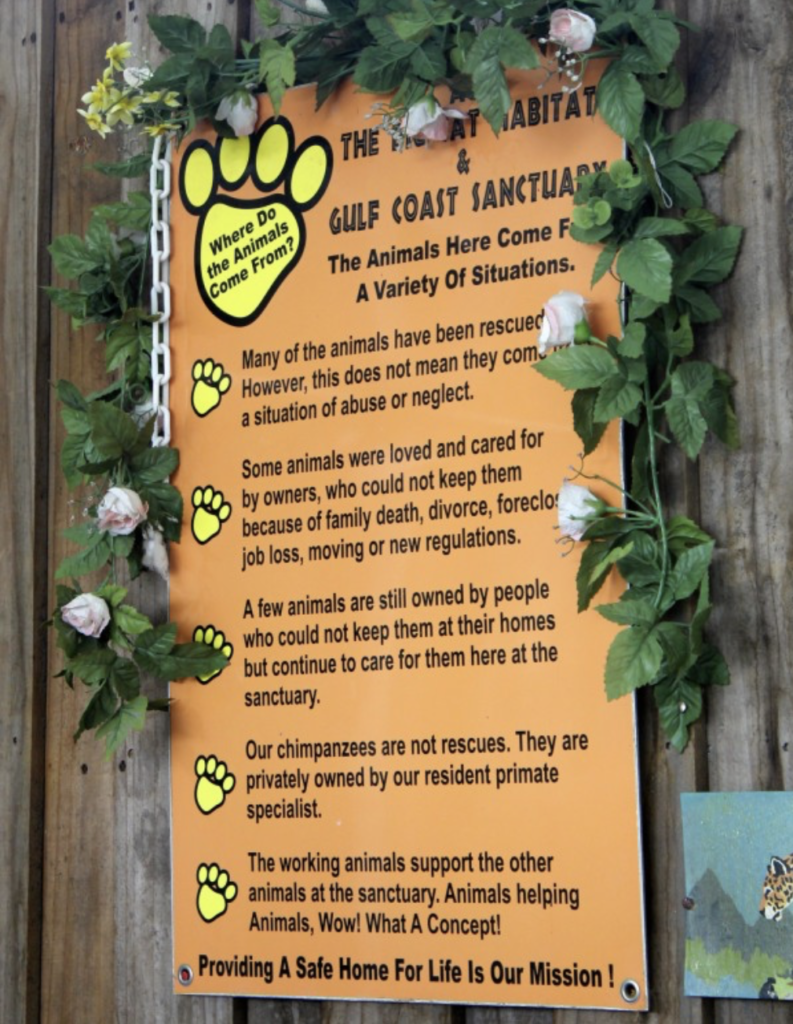
Although Big Cat Habitat is not known to breed big cats themselves, they have obtained young cubs from breeders and have frequently exhibited tiger cubs (which they claim are temporarily “leased” from other exhibitors) at local venues for profit. This 1996 news article talks about Kay Rosaire purchasing two tiger cubs from Marineland USA to exhibit at an amusement park, and in 2011, a 4-month-old tiger cub named Gandhi was exhibited by Big Cat Habitat at the Ringling Circus Museum in Sarasota.
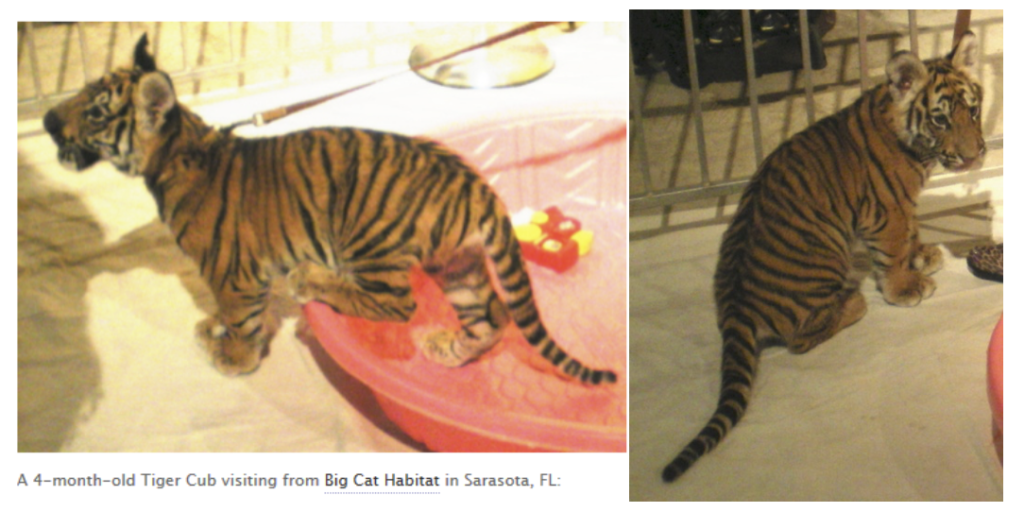
After his museum appearance, there were no records of a tiger named Gandhi ever living at Big Cat Habitat. But in 2016, a tiger named Gandhi was filmed being brutally beaten after attacking Florida-based circus trainer Vincenta Pages during a performance at a fair. It’s entirely possible that this is the same tiger.
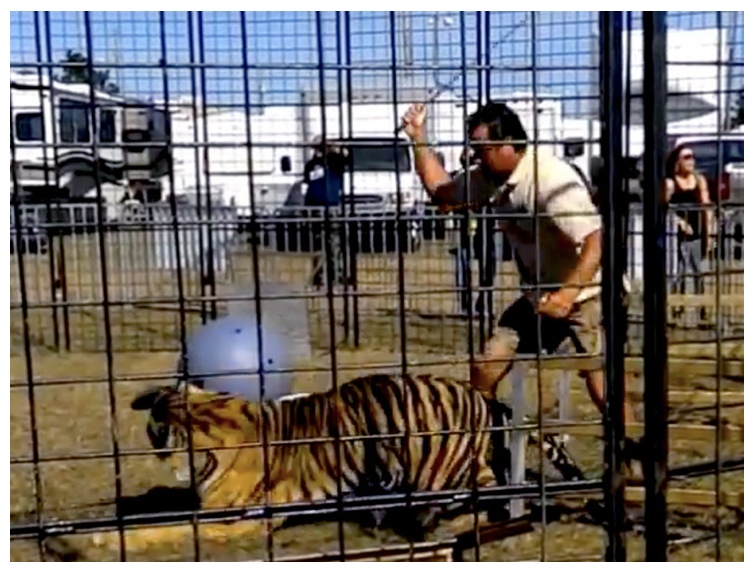
An older version of the Big Cat Habitat website admitted that their two star white tigers, Barry and Vanna, were “born 2009 at a sanctuary in South Florida and were transferred to ours in early 2010.” Facebook photos of that time show Clayton Rosaire walking his new cubs on a leash in his backyard. Sanctuaries do not breed and “transfer” cubs.
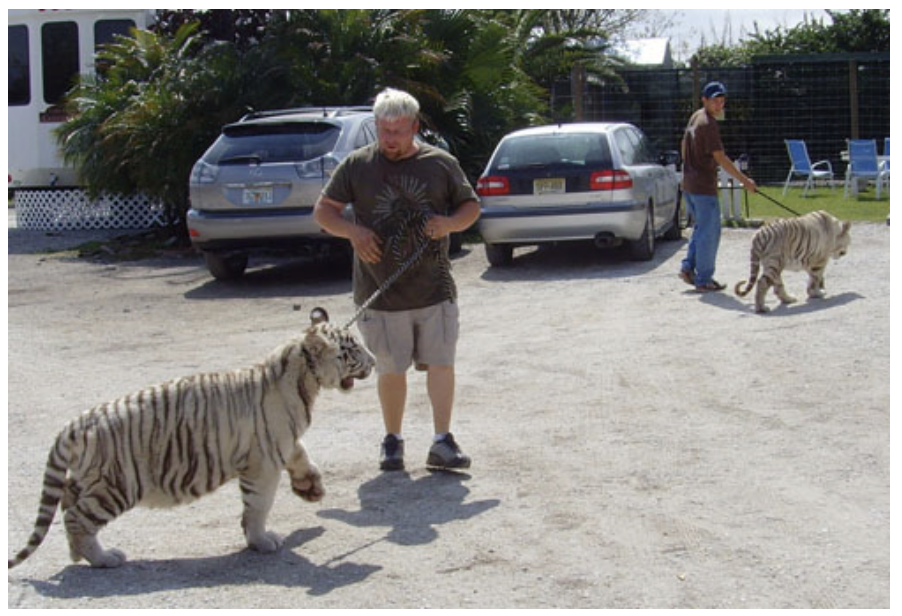
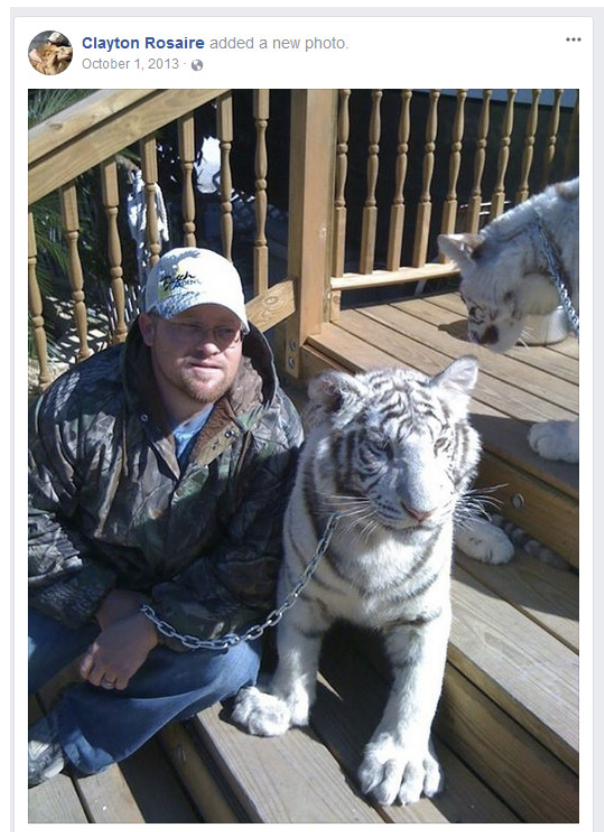
Big Cat Habitat’s performing liger, Mia, came to the pseudo-sanctuary as a 10-month-old cub. Big Cat Habitat’s website claimed that Mia the Liger “came from a very good sanctuary in Illinois” but the only known Illinois facility with ligers is Woody’s Menagerie, a notoriously abusive private breeder with a history of slaughtering unwanted big cats.
In 2016, Big Cat Habitat received a hybrid Tigon named Rhajah from Susan Pearce, the owner of a pseudo-sanctuary called Animal Adventures which has since been shut down by the Florida FWC for poor conditions. In a news article, Pearce explained that “my animals were signed over to my good friends several weeks ago. I did that to protect them.”
A 2018 news article mentioned that a porcupine named Bess “just arrived at the Big Cat Habitat from a breeder of African Crested Porcupines in Myakka City. Kay Rosaire said the area does have its share of exotic animal breeders, which isn’t a bad thing for some of the species which are struggling in their natural habitat.”
Read what visitors had to say about Big Cat Habitat & Gulf Coast Sanctuary:
“Oh boy do I feel like a sucker. I can’t believe I paid almost $20 to support this “sanctuary.” This place is sad and depressing. It’s cramped and hot and the animals seem extremely unhappy. They call this a safe haven for animals but it’s pretty much a low level circus with a daily show where they taunt and tease the animals. The owners used to train the animals for the circus, but got a lot of backlash, so basically they “rescued” their own animals and now call themselves a nonprofit and charge high fees to take care of the animals that they abused! I felt very uncomfortable here. I can’t believe Sarasota allows them to continue.”
“This place is not a rescue nor a sanctuary. It is a roadside zoo/amateur circus of the worst kind. The cages are ridiculously small and the animals are made to perform degrading “tricks.” They claim that some of the cats have been rescued, but openly state that the chimps are privately owned by a primate “expert.” Primate experts don’t make chimpanzees wear human clothing and perform stupid tricks.”
“This place is just confusing. I see the word “Sanctuary” and I think save haven, place for animals to live life as closely as possible to how they would in the wild or at least just comfortably. Corralling huge elephants up in a really small roped off pen for hours while another elephant gives rides to people on his back in a tight circle (for cash! ding ding!) is the exact opposite of that. There’s a small alligator with his mouth taped shut that they charge $5 to pose with. What a great life for the alligator! Tigers, lions, ligers are paraded out and made to perform tricks daily. The only thing they have going for them is they don’t whip them (so they say) but I’m not sure having them perform is very dignified or kind. Ponies tethered, walking in a circle for kids to ride, bears being fed salty hot dogs as a reward for waving – again, no dignity. I laugh when I hear “They enjoy doing it”. No they don’t, it’s all they know. They’re doing it because they learned a long time ago if they don’t, someone will beat them. You’re just taking advantage of that broken spirit and changing out food treats for whips. If you listen to the show’s message, they talk about treating the animals with respect and dignity. It’s like they don’t know what those words mean. I felt really uncomfortable there. The employees really seem to care about animals but they also seem to be drinking the same koolaide so they won’t see the reality of it all.
On one hand, yeah ok they aren’t being treated as badly as circus animals that are dragged from city to city. But as I watched an Alaskan bear pace back and forth, panting in the heat, I wondered if euthanasia wouldn’t have just been more humane. It just seems like a shitty life. And I paid $15 to have it continue. Not doing that again.”
“Disturbing experience. I saw tigers, lions, and bears endlessly pacing back and forth in their tiny caged enclosures. The circus performance — with its whips and chains — was equally upsetting. Not sure how such places are allowed to exist, no less call themselves a sanctuary. Recommendation: Save yourself the expensive entry fee, not to mention the annoyance of their relentless pleas for yet more “donations” while you’re roaming their zoo (…for the record, the owners are already quite wealthy…) and head to a state park where you can witness wildlife roaming free in its natural habitat. You’ll be supporting a true sanctuary.”
“This place IS NOT A SANCTUARY!! I asked several of the people who worked there about the animals thinking they could share their story and how they now have a better life. The answer from each was “random zoos around the country or a private owner”. This place purchases their animals.”
“This place is more like a roadside carnival. Small animal enclosures, cash for “tricks”, carnival environment. Maybe they have saved some animals, but they are surely exploiting the animals for money and to feed their human mobile home community inside of the “sanctuary”.
“The cats were in pens about 6 x 8, cement flooring. They looked absolutely miserable. How the owners of this facility get away with this is beyond me.”
“This place is anything but a sanctuary, it is a roadside zoo! There was a poor bear pacing back and forth, back and forth, in a VERY small, cement enclosure. Anyone who knows animals knows this is a sign of distress. Sadly, he was not alone in his misery, there were others. They broke my heart. Anyone considering visiting this place, PLEASE reconsider and find a true sanctuary where the animals come first, not making money off of their suffering!”
“I was very excited to visit the animal ‘sanctuary’ this morning and left the backyard circus extremely depressed. Wild animals such as tigers, lions, and bears are not meant to be kept in tiny cages the size of my bedroom or smaller. I had the impression a sanctuary was a place for animals to be rehabilitated and to be reintroduced to a wilderness -like environment. Instead, they are now a part of an awful circus act and forced to act in front of a yelling and gawking audience. They paraded a poor chimpanzee on a chain in front of us and forced him to do flips and walk with a limp, and there were barely any toys in the animals pens. The most I can say is that the animals seemed healthy, but they did not look happy at all.”
“I love animals and thought this was a sanctuary, however this was a circus where the animals were made to perform. Didn’t like the fact they were in small sterile cages with no enhancement. Would not go again not my kind of sanctuary.”
“I was looking forward to see big cats in a sanctuary environment. Instead, I saw a zoo/circus. Many of the tigers were injured or had obvious flesh wounds. All were in small cages: many were panting, all were pacing. The bears there were also pitiful – pacing and exhibiting bored self-injurious behavior. I was delighted to have missed the “show” which sounded from the outside exactly like a circus. Patrons are permitted to buy chunks of meat to put on metal sticks and “feed” the animals. Most patrons force the animals to stand up for their food and some taunted them in the process. I was thoroughly disgusted. The animals are majestic and beautiful. I confess their cages seemed mostly clean but their environment was pitiful. The big cat habitat is not a sanctuary. If you’re sympathetic to animal suffering, pass on this destination.”
“This place is neither Habitat or Sanctuary. It is currently located on a very small piece of property. Animals are all caged in shockingly small accommodations – especially the big cats and bears. There are no rescued animals here – the signage and personnel say so. There are animals that other exotic pet owners have given to this family because they can no longer care for them. This is a family owned business that includes using animals of all kinds in their own circus and leasing animals to other circus companies. You will need to “sign in” as the employee who took our entrance fee indicated. “Signing In” meant that we signed a personal liability waiver. Just as we (my husband and 2yr old) stepped 1 foot beyond the front entrance, all of the big cats started roaring. This was alarming as it is quite loud and they’re all SO close together. We heard several employees yelling in panic around a corner. One employee ran past us in a panic like he was running for his life (from the big cat cages). He ran into a house on the property and then ran back out toward the cat cages with several dogs in tow. Still employees are heard yelling. As we came around the corner we inadvertantly witnessed an employee threatening a Liger with a whip. The cat had clearly been whipped before because this massive cat jumped every time the whip was cracked (by the employee in an adjacent cage). We were told that the cat had been trying to tear the wire in the “play enclosure” and they were afraid he would hurt himself or eat it so they were trying to get him back into his cage. They eventually coaxed him back in with food. However the panic of the employees, roaring of the upset cats and the liability waiver all scared us. We were then given a tour of the cat cages by an employee who approached each cage with handfuls of whip cream on her hand and let each one lick it off through the cages. We didn’t stay much longer. Before you visit this place and give any money to supporting them, google the name of the owner and read what we read (after the fact): Kay Rosaire.”
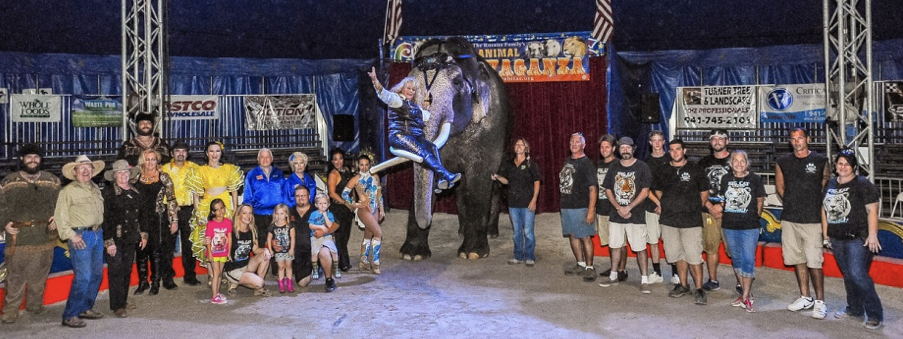
The Rosaire family poses with an elephant under Big Cat Habitat’s circus tent.
According to the synopsis for the documentary The Rosaire Family Circus:
“The Rosaires are acutely aware that their traditional way of making a living is slowly dying. However, they continue struggling to keep it alive because it’s in their blood and it’s all they know. When tragedy befalls the family not once but twice, they decide to attempt what they’ve been unable to do for over 50 years – quit the road and create a family circus on their property in Sarasota, Florida.”
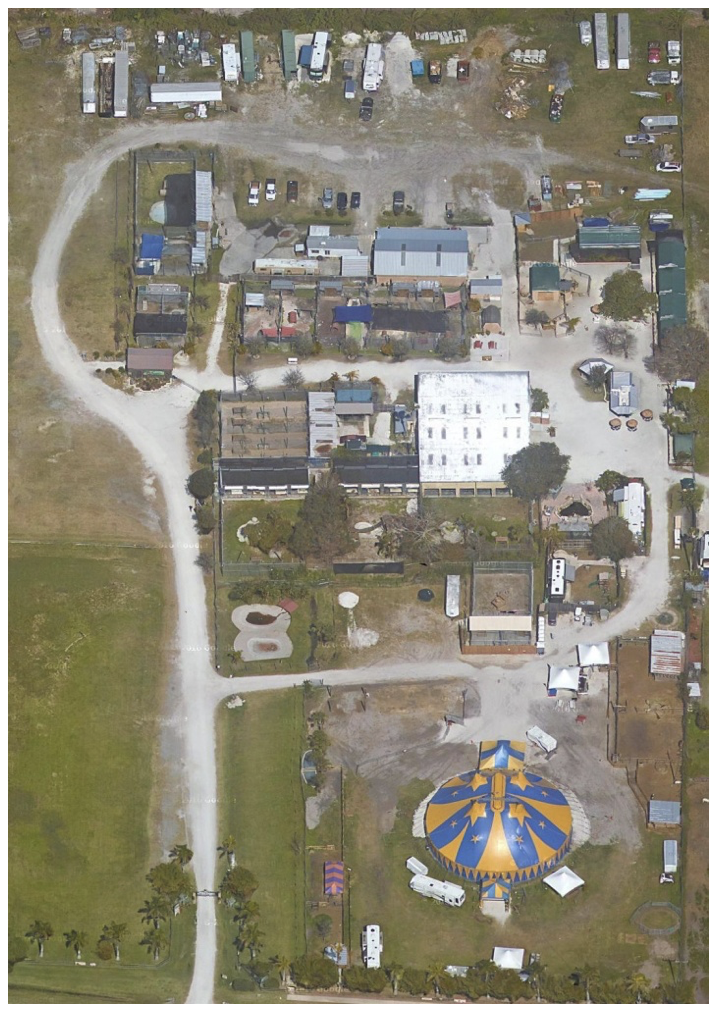
A 2018 aerial view of Big Cat Habitat and Gulf Coast Sanctuary, complete with a big top tent.
Before 2015, Big Cat Habitat’s website promoted “Kay Rosaire’s Big Cat Encounter” as follows:
“Kay Rosaire steps into the huge steel arena and brings gasps of appreciation from the audience when her will and skill prevails over the deadly strength and stealth of the tiger and lion. Respect is the key word, according to Kay. She respects the natural ability of her charges and they respect the fact that she is the master, the one they must obey. This does not come easy. Hours and hours of patience and perseverance in training are involved and the result is that circus patrons are treated to a rare display of a fearless young lady’s command over savage jungle beasts.”
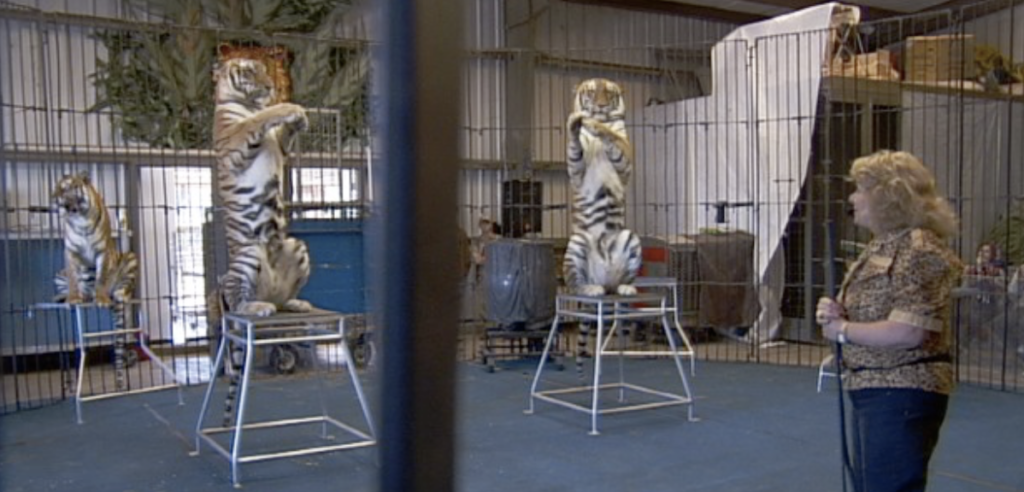
Admission to Big Cat Habitat still includes a daily presentation of the Rosaire’s circus act, rebranded as an “educational demonstration.” Visitors gather around Big Cat Habitat’s onsite circus ring to watch a whip-wielding trainer (usually Clayton Rosaire) command the big cats to jump through hoops, stand on their hind legs, and do other unnatural, cruel tricks for the “enjoyment” of the audience. Despite the sanctuary’s slogan of “respect and love” for animals, the show features Rosaire treating the big cats as house pets (not the message a responsible sanctuary wants to send), taunting them, and cracking jokes at their expense. Big Cat Habitat claims that the animals in the show “work to support the other animals,” but no true sanctuary would ever exploit some animals in order to save others.
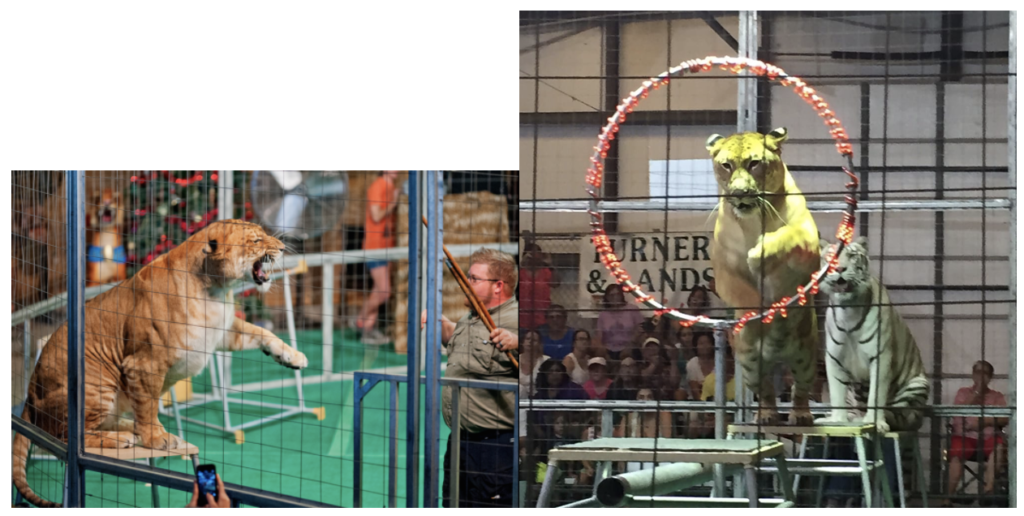
Scenes from Big Cat Habitat’s daily “educational demonstration.”
Big Cat Habitat’s Yelp account claims that these photos of tormented tigers depict “natural behavior”:
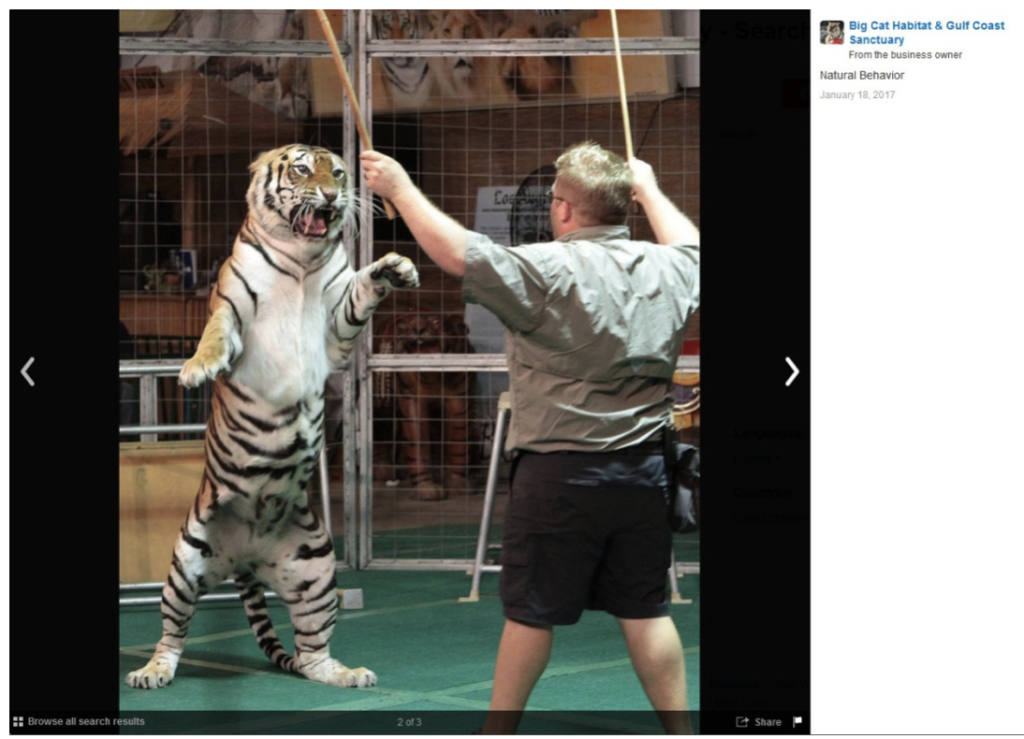
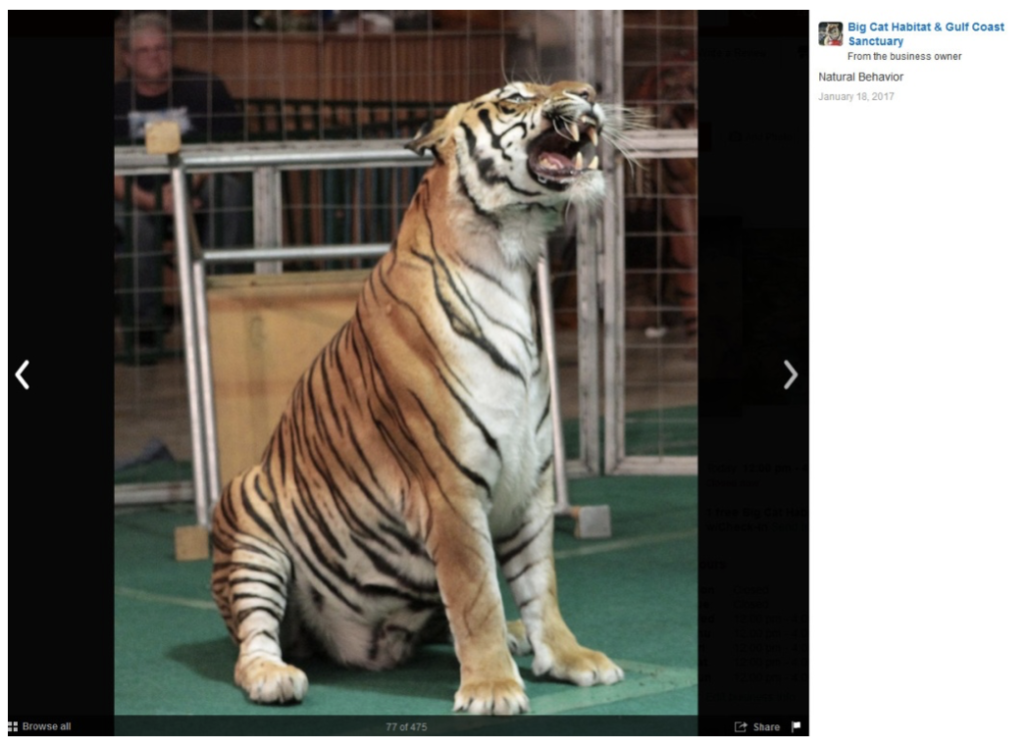
On weekends during the tourist season, Big Cat Habitat sometimes features additional performances by Frederick and Derrick Rosaires’ muzzled circus bears, who are forced to walk upright, ride motorcycles, and hop over hurdles. Pamela Rosaire-Zoppe’s chimpanzee, Chance, is also frequently seen in the ring doing tricks for the audience with a rope around his neck. Chance has been rented out by the Rosaires for a variety of commercials and films, including “The Wolf of Wall Street” which also featured one of Big Cat Habitat’s lions.
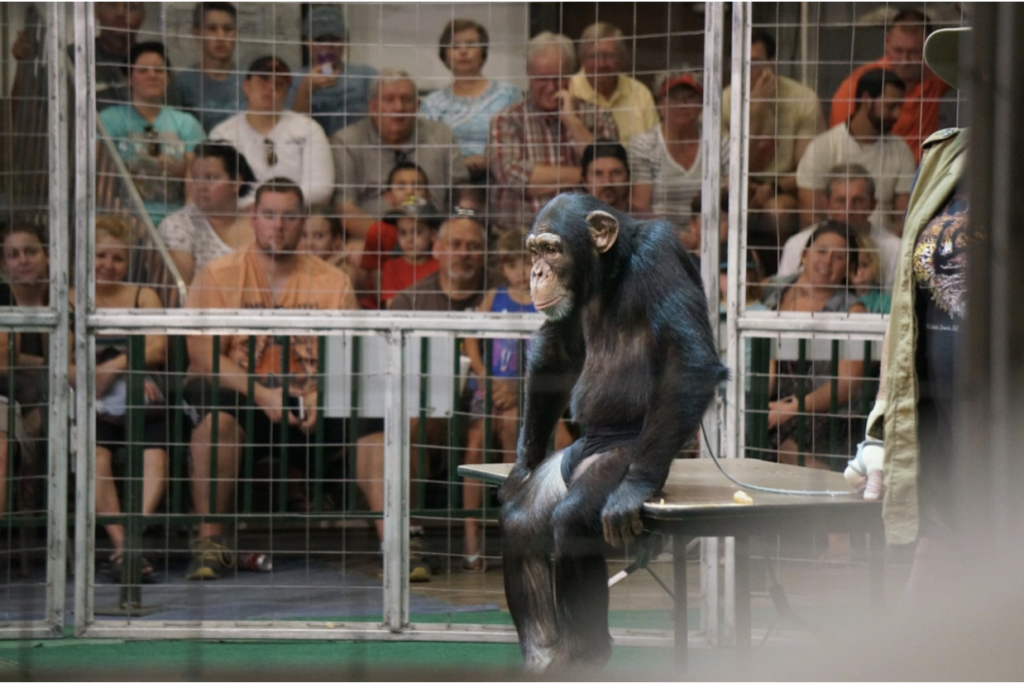
Chance the chimpanzee during a performance at Big Cat Habitat. Pam Rosaire, Chance’s owner and trainer, has said she forces young chimps to “do what they’re told” by isolating them “until they listen.”
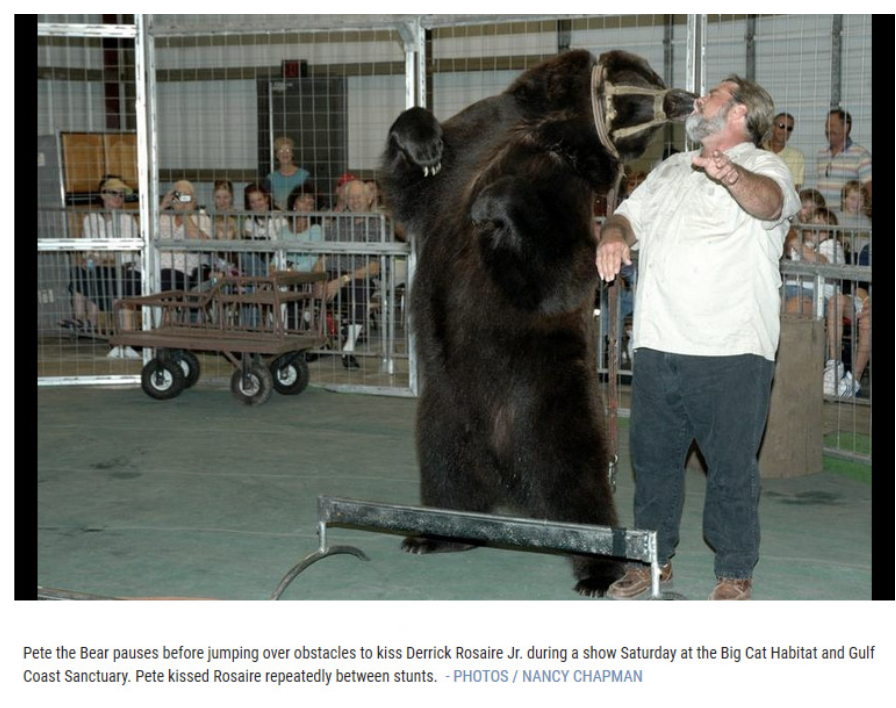
After each performance, a white tiger is crammed into a tiny Plexiglas case so that visitors can pay $10 to take a photo with him. Note the raw sore on this cat’s elbow from a lifetime of lying on concrete in his barren cage. The tiger in the top photo also appears to have an injured eye.
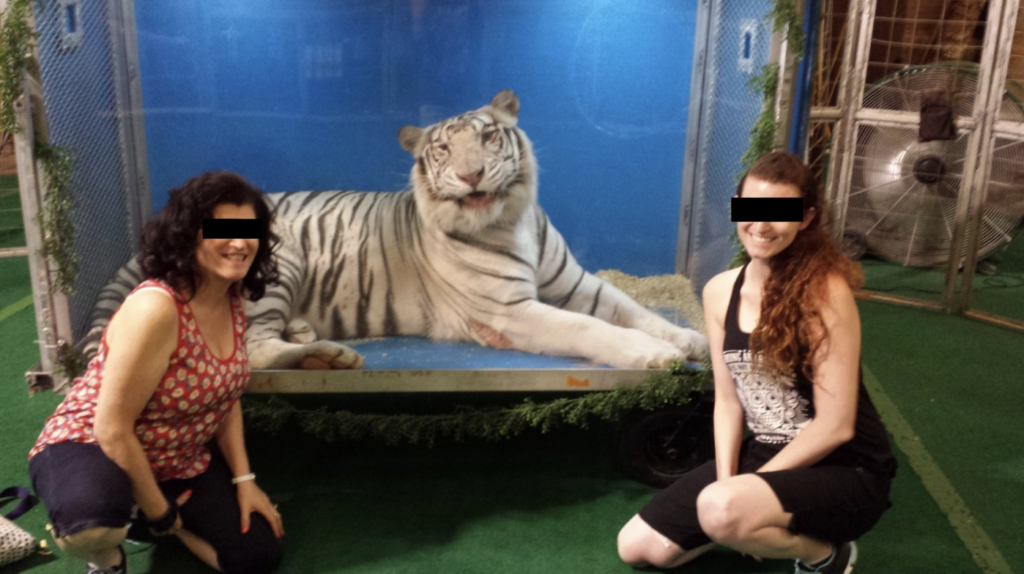
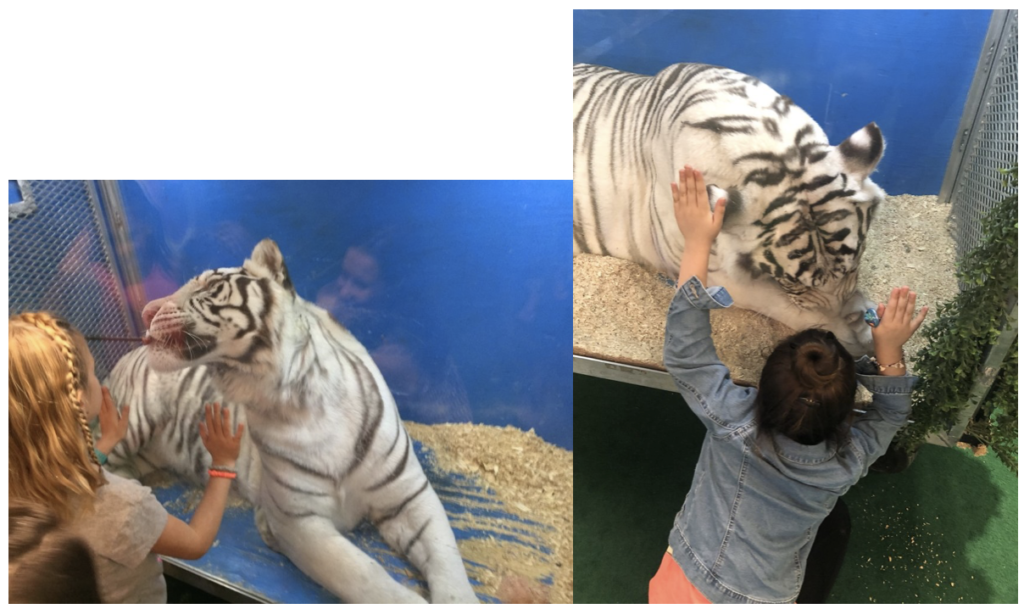
When not performing, most of Big Cat Habitat’s big cats are warehoused in rows of barren indoor concrete cells, with nothing to do but pace in circles or stare blankly into space.
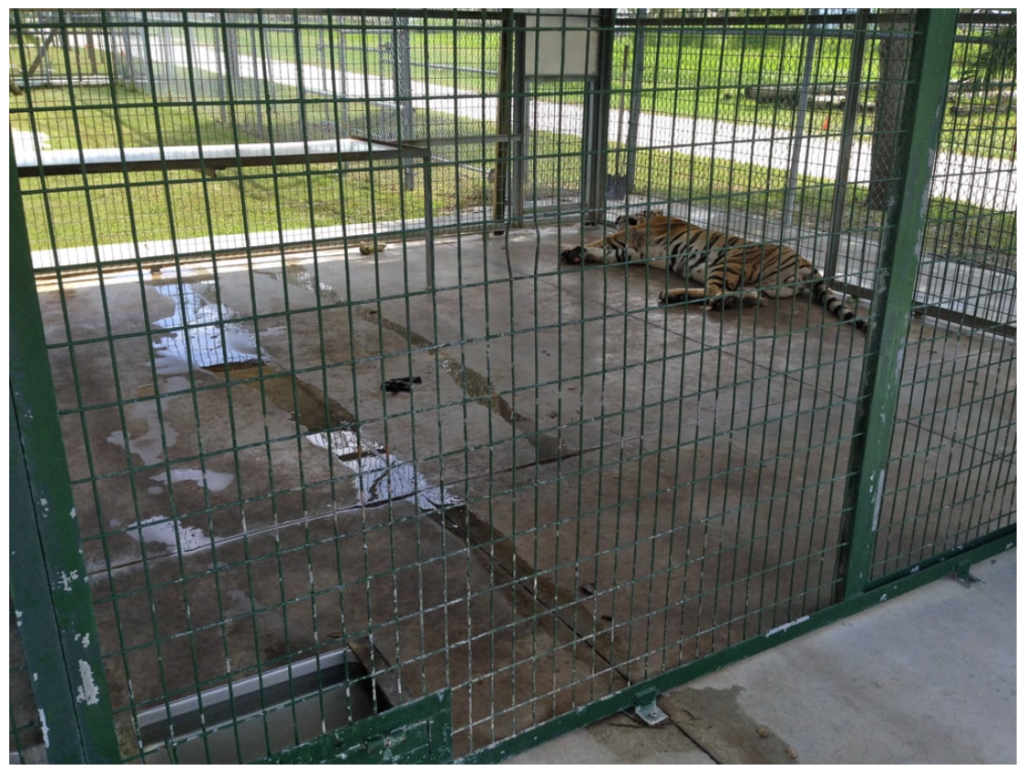
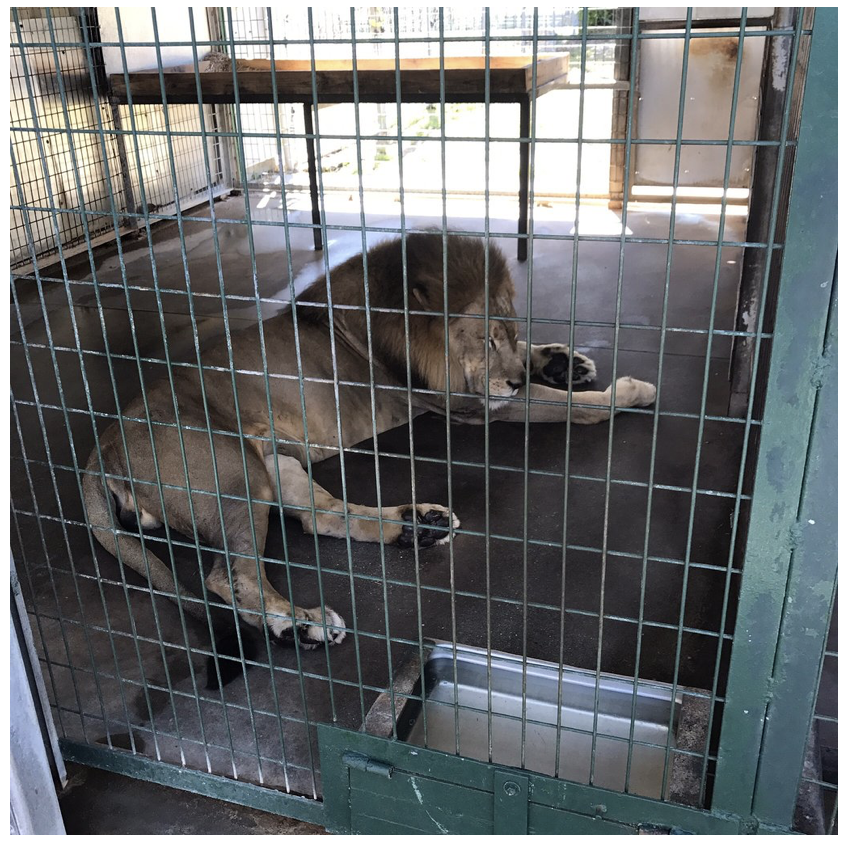
Although the cells do have access to a few larger outdoor yards, all of the cats must be rotated through them. Big Cat Habitat claims that all of the cats get just 2-3 hours of “outside time” per day, meaning (if this is even true, which is doubtful) that they still spend the vast majority of their lives on concrete. Some of Big Cat Habitat’s tigers have visible pressure sores called hygromas on their elbows which are commonly seen in circus tigers and are caused by the trauma of repeatedly lying on a hard surface. If left untreated, hygromas can become infected.
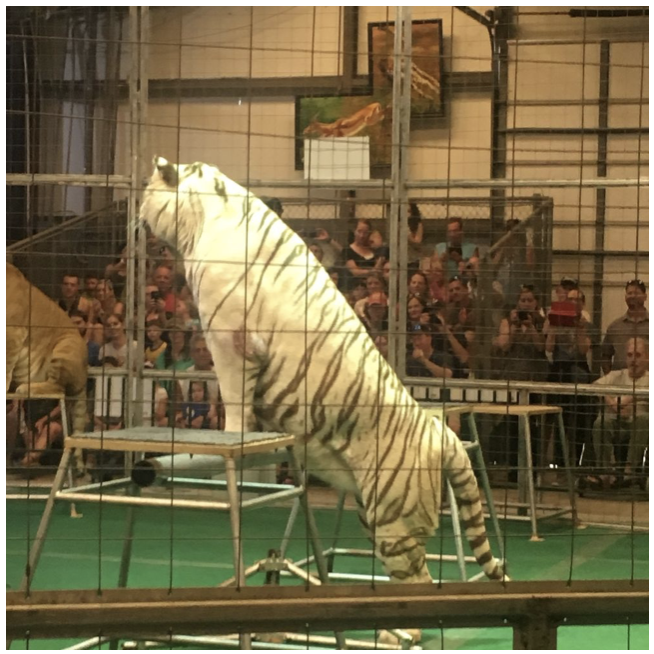
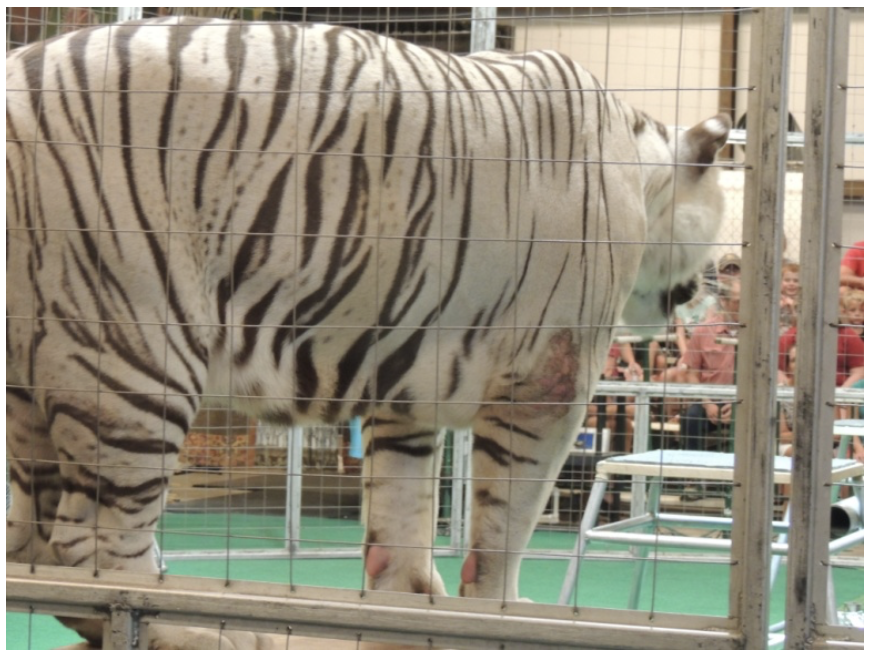
A 2017 video filmed at Big Cat Habitat shows one of the white tigers repeatedly sucking on his tail and a monkey which had groomed almost all of the fur off of its tail. Tail-sucking and excessive grooming are behaviors indicating severe psychological distress in captive animals.
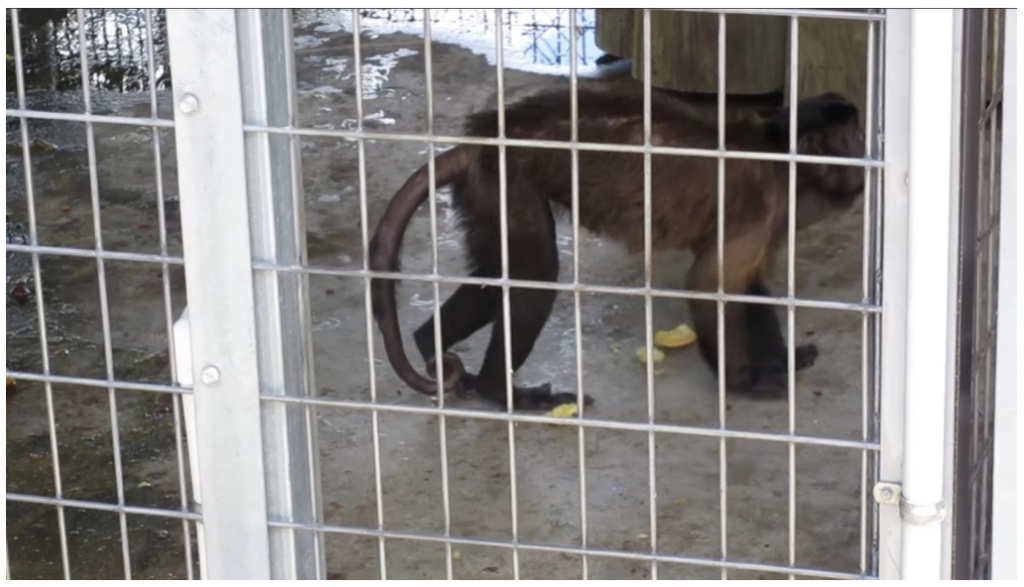
A tourist filmed “Handsome,” Big Cat Habitat’s star performing lion, lying motionless in his cage with a vacant stare.
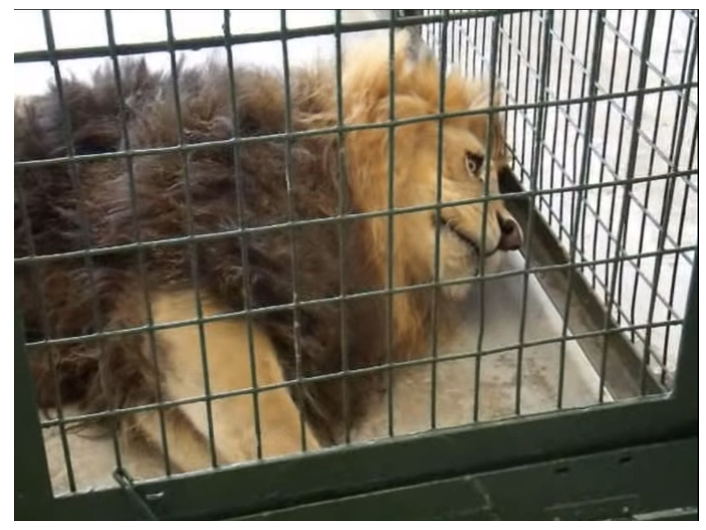
This tiger, photographed at Big Cat Habitat in May 2018, has patches of missing fur suggestive of a ringworm infection. Another tiger appears to have slight cracks and irritation on the skin of his paw pads. Captive big cat expert Jay Pratte notes that cracked pads “historically [are] a result of constantly living on concrete or metal floors, which are hosed clean and remain wet for long periods of time. These cracks will also dry out and are extremely painful to the animals when they move—and even when they’re at rest. Severe cracks can also become infected, causing further skin and tissue damage. Big cats will often groom and lick cracked pads, which over time can develop into a stereotypic behavior, particularly in such a sterile, non-enriched environment.”
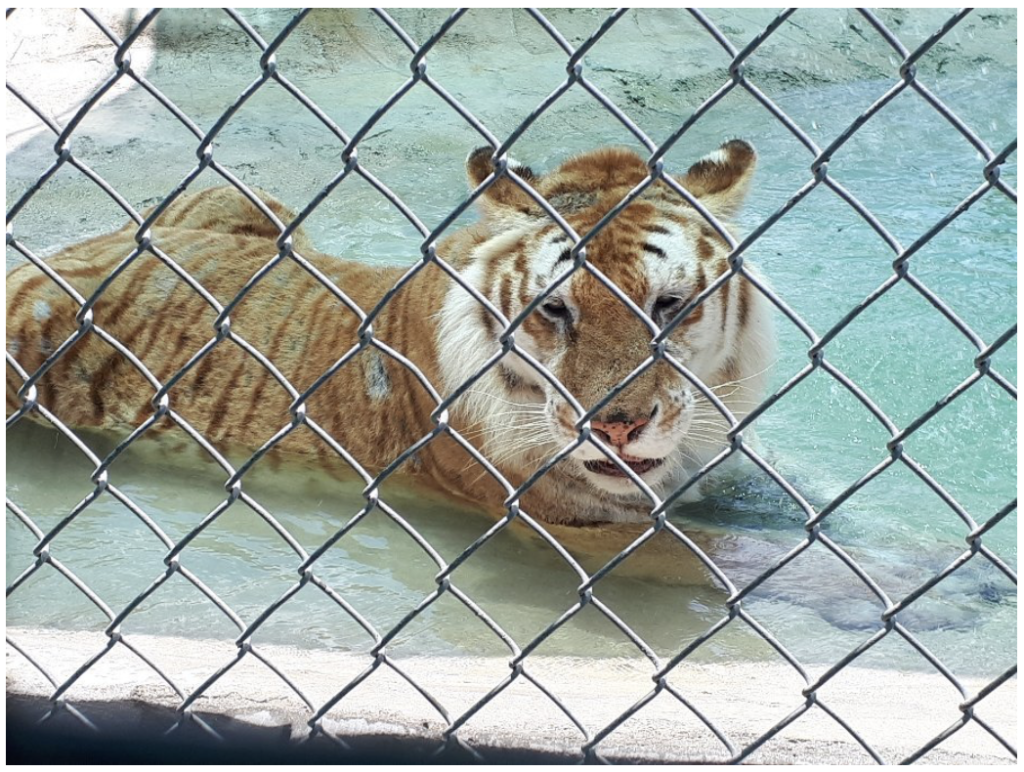
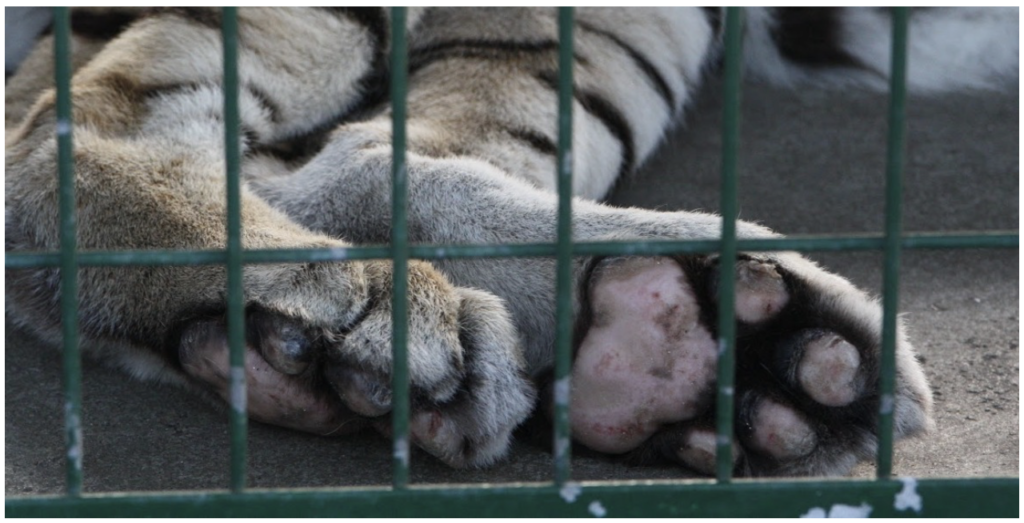
As of 2018, Big Cat Habitat has been housing a wolf and a young lion in the same cage. This is a big no-no that a responsible animal facility would never do.
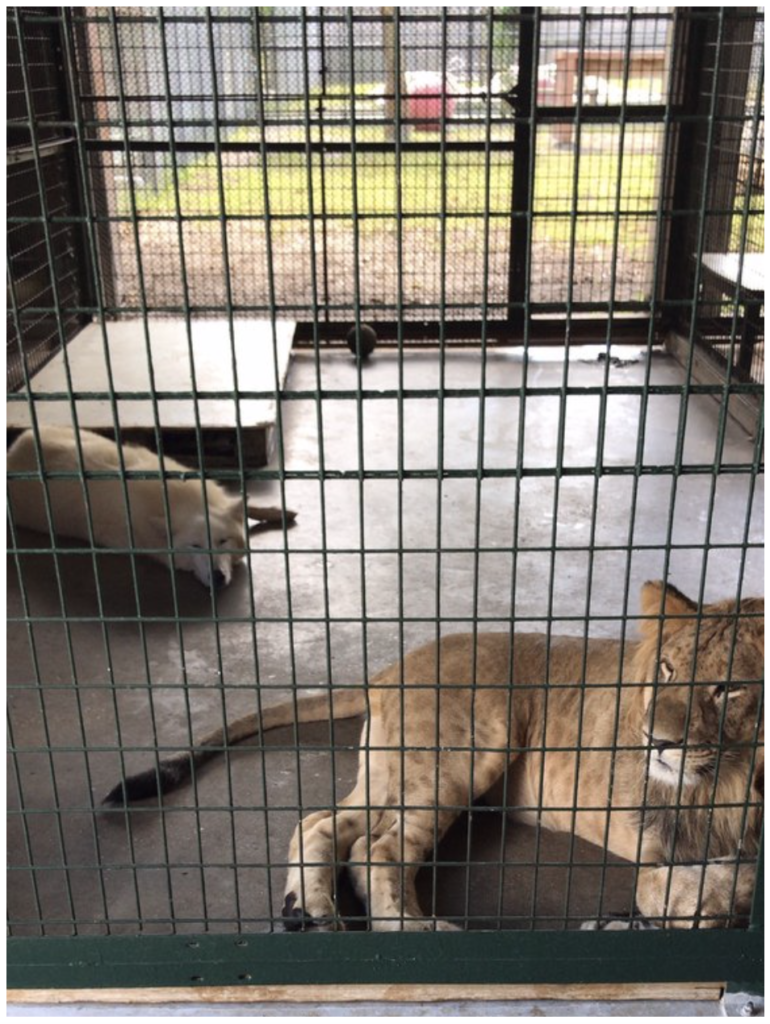
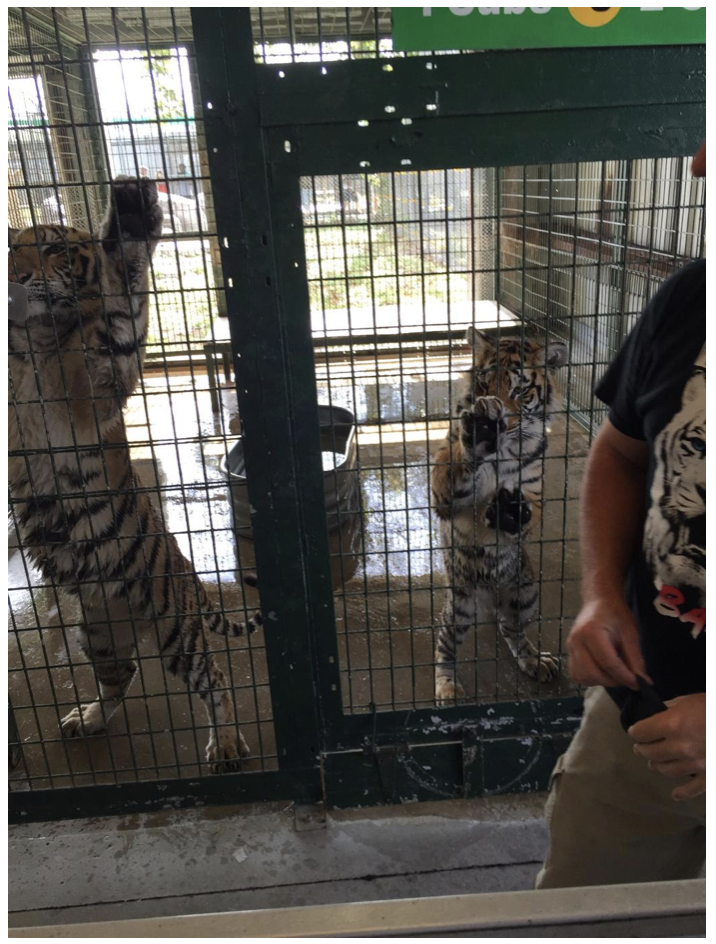
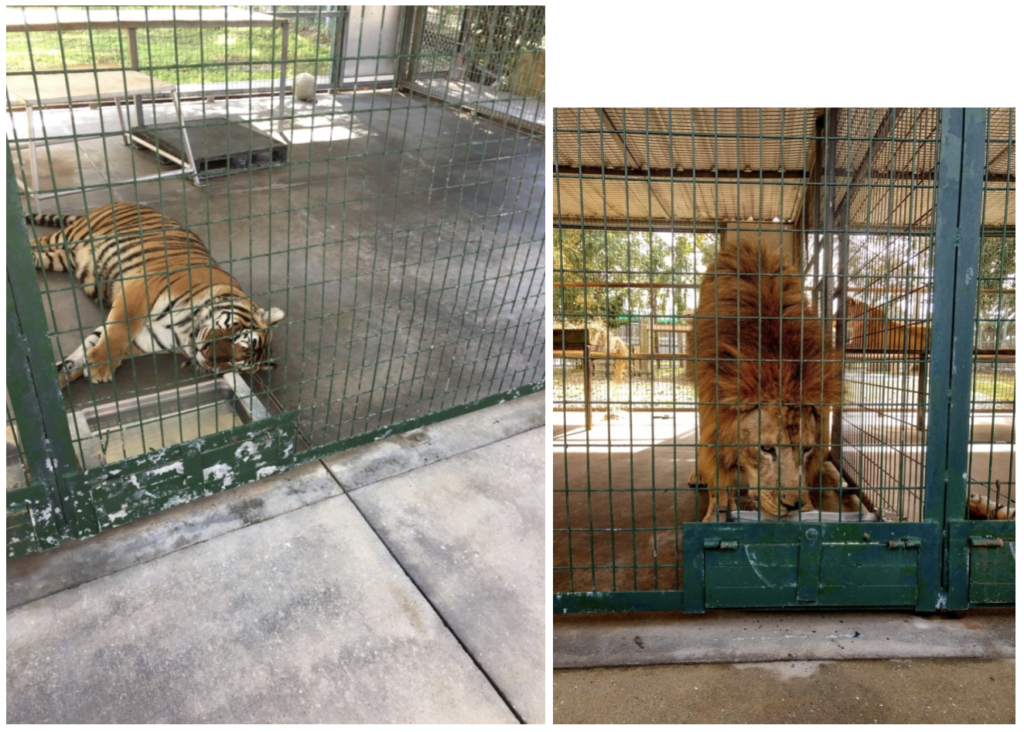
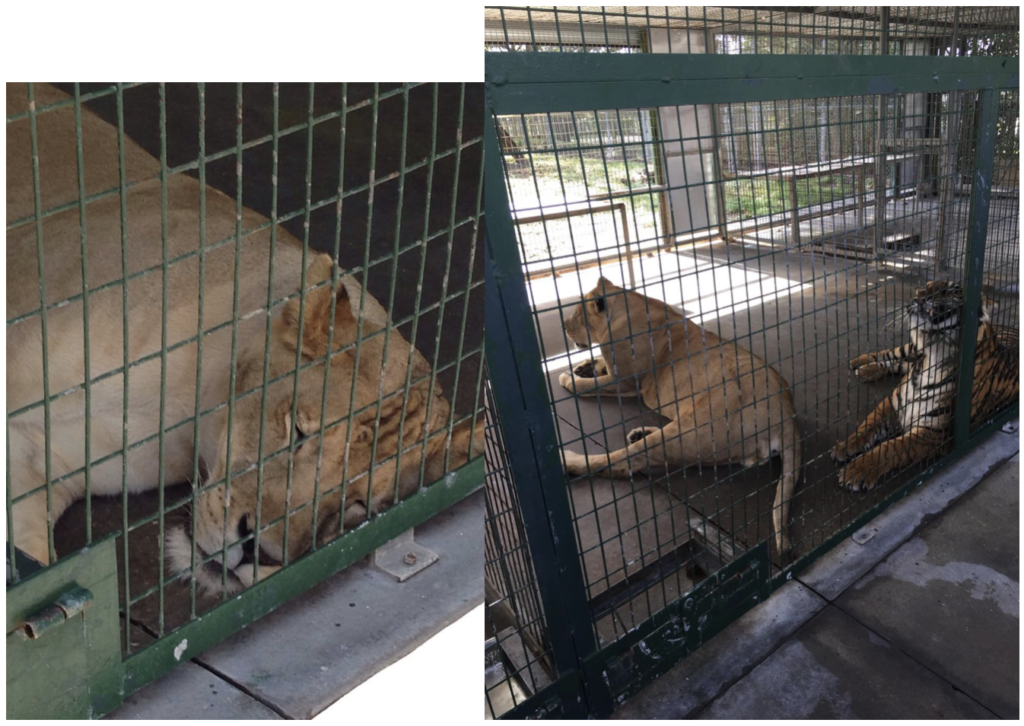
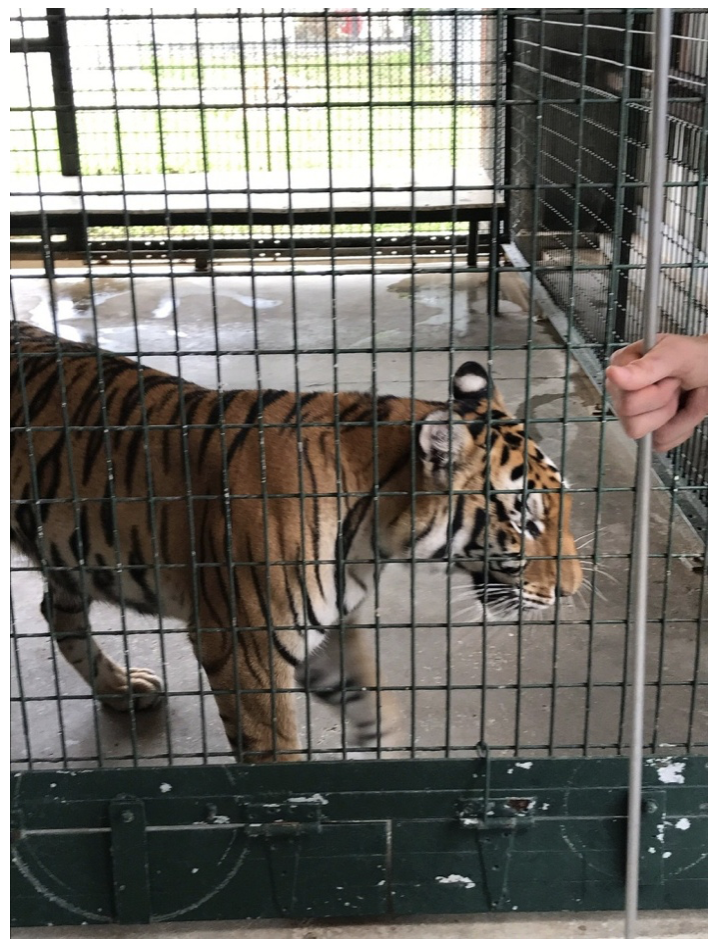
Never missing an opportunity to profit off of the animals, Big Cat Habitat encourages visitors to pay an extra $5 for the opportunity to feed the caged big cats meat off of a stick. Raw hot dogs can also be purchased for $1 each to feed to a “waving” bear.
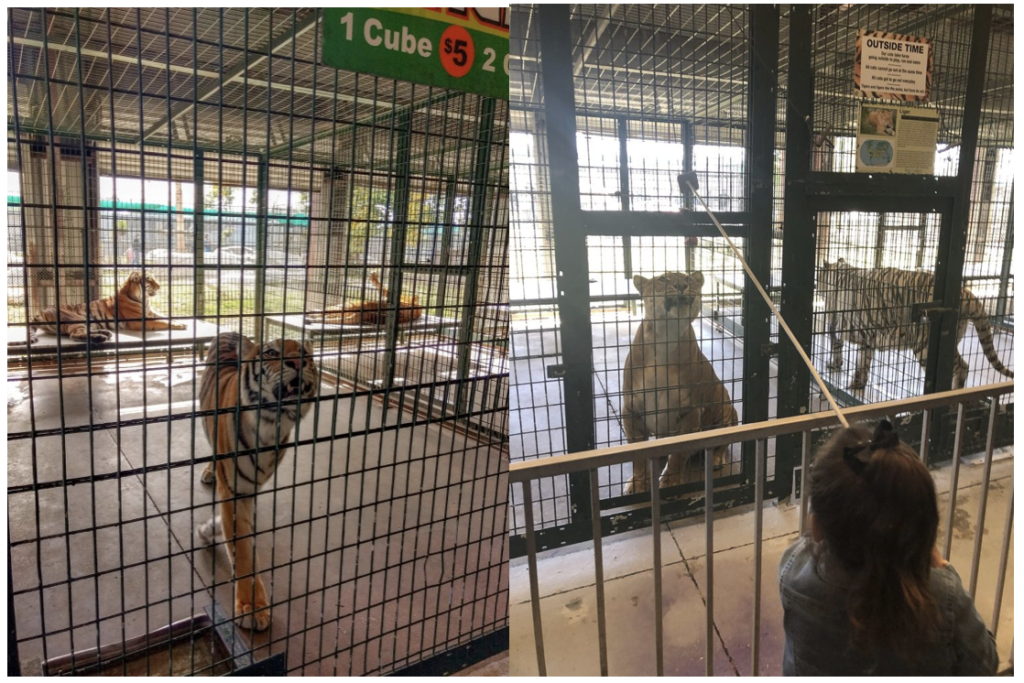
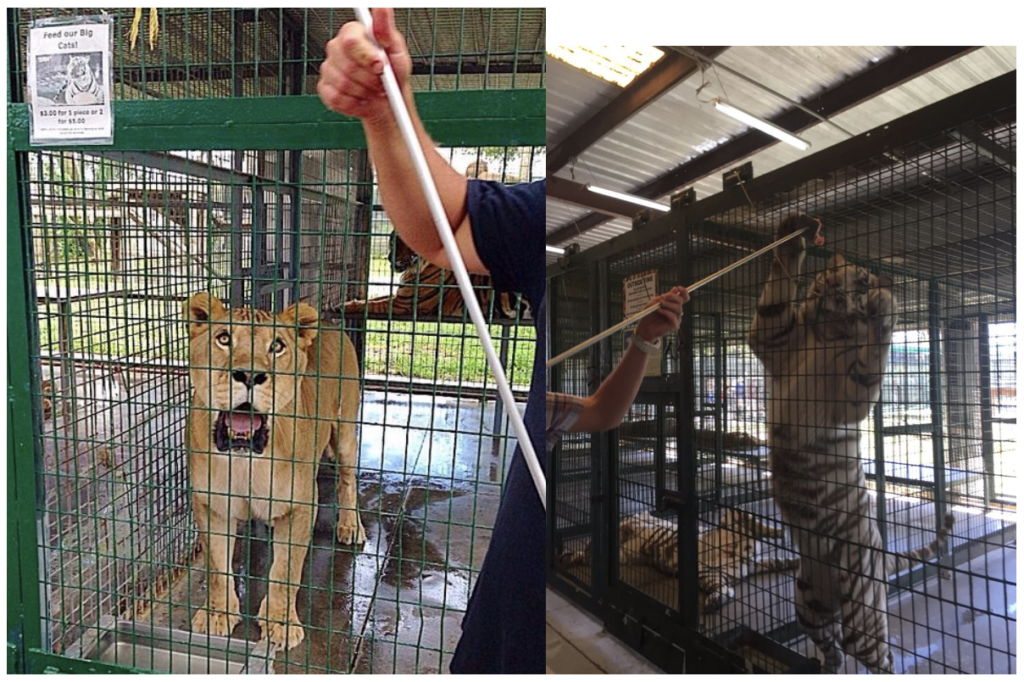
“Big Cat Habitat Animal Extravaganza”
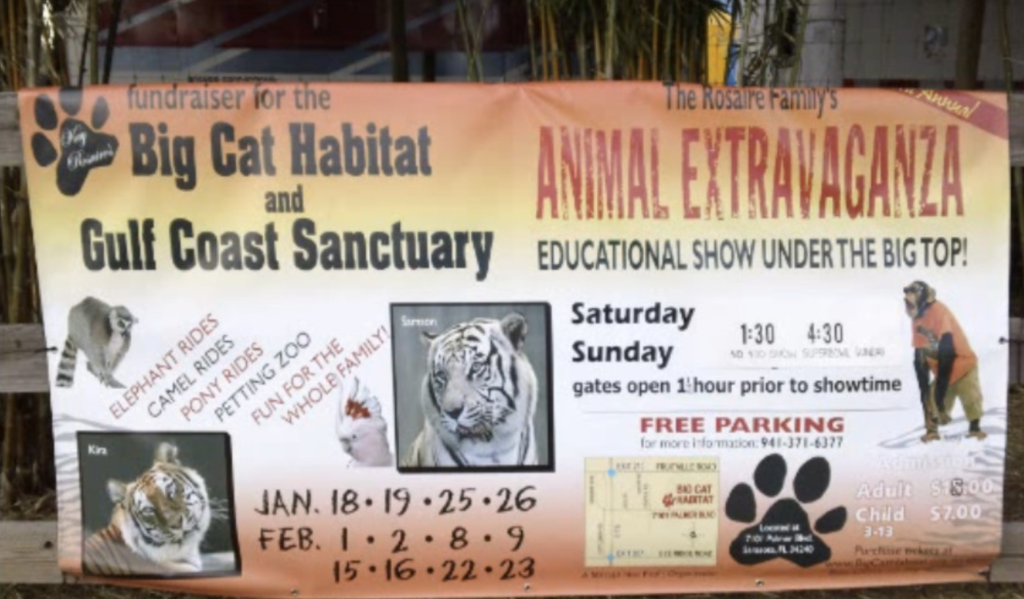
Kay Rosaire used to promote the event as a “Circus under the Big Top,” but recently replaced the word “Circus” with “Educational Show” to legitimize it. Although the name changed, the circus acts remain the same.
Every February, Big Cat Habitat sets up a big top tent on sanctuary grounds for its biggest fundraiser, a series of weekend circus shows featuring Big Cat Habitat’s animal acts and performances by other local circus animal trainers. The old-fashioned event even sells elephant rides provided by Two Tails Ranch, a roadside zoo affiliated with the notoriously cruel Tarzan Zerbini Circus. The elephant most commonly used at the event is named Luke, who gives performances and rides at Big Cat Habitat despite having tested positive for tuberculosis, a serious respiratory disease which can be transmitted from elephants to people. In 2011, the USDA cited Two Tails Ranch for endangering public health by continuing to exhibit Luke even though they knew he had untreated tuberculosis since 2008. In 2012, the USDA repealed tuberculosis monitoring and testing requirements for elephants altogether, making it impossible to know whether or not a performing elephant is infectious at any given time.
These photos from previous Big Cat Habitat extravaganzas include motorcycle-riding bears, a shackled elephant balancing on a ball, and chimps doing dangerous tricks while dressed in humiliating costumes, all underneath a banner proclaiming Big Cat Habitat’s “respect” for animals.
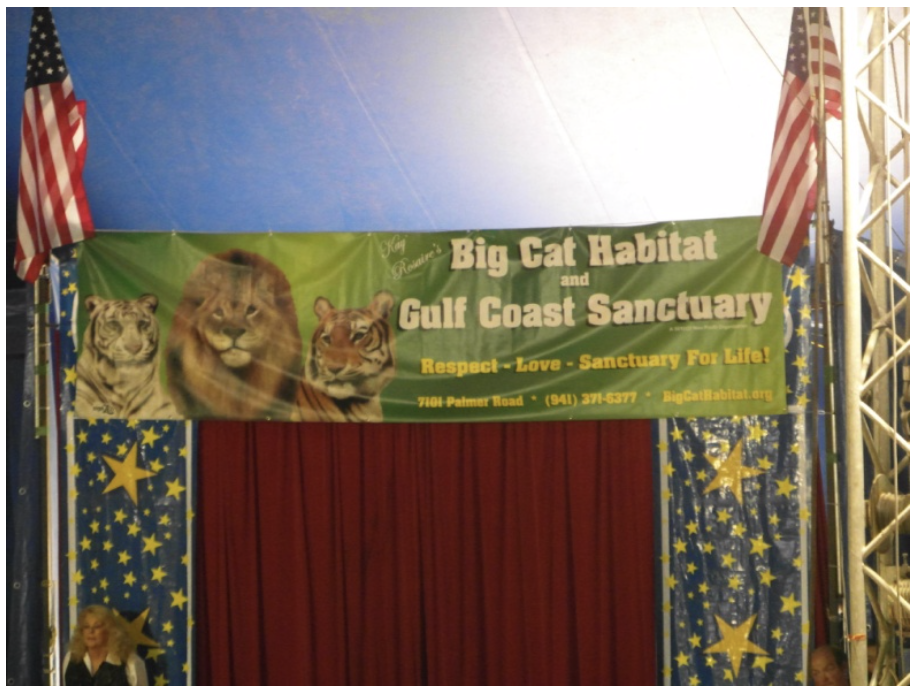
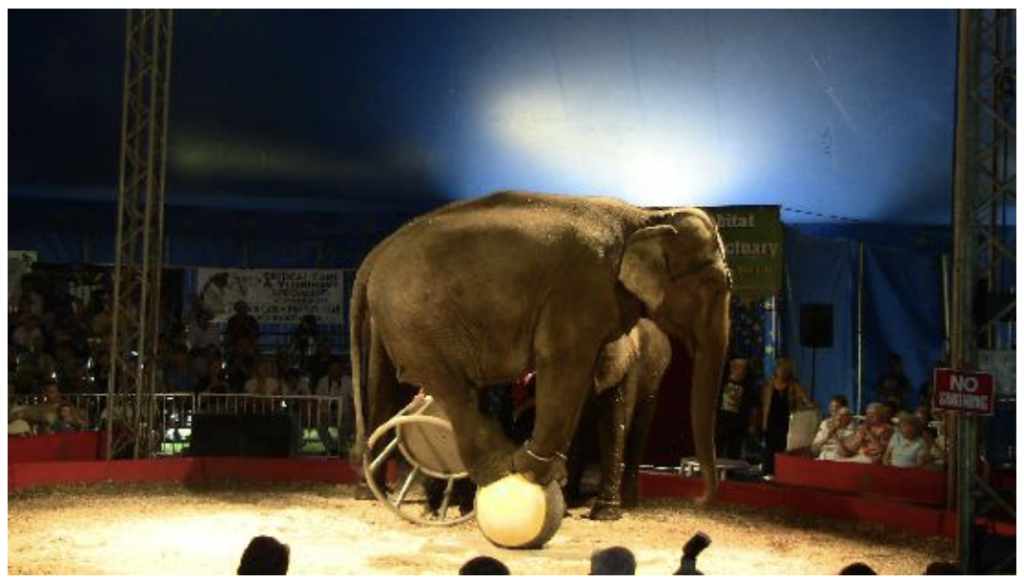
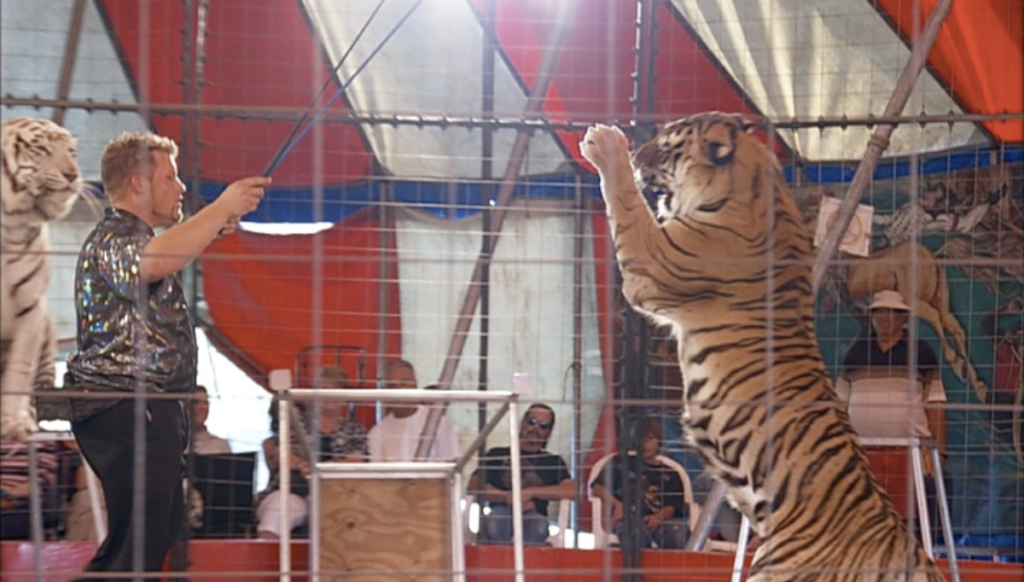
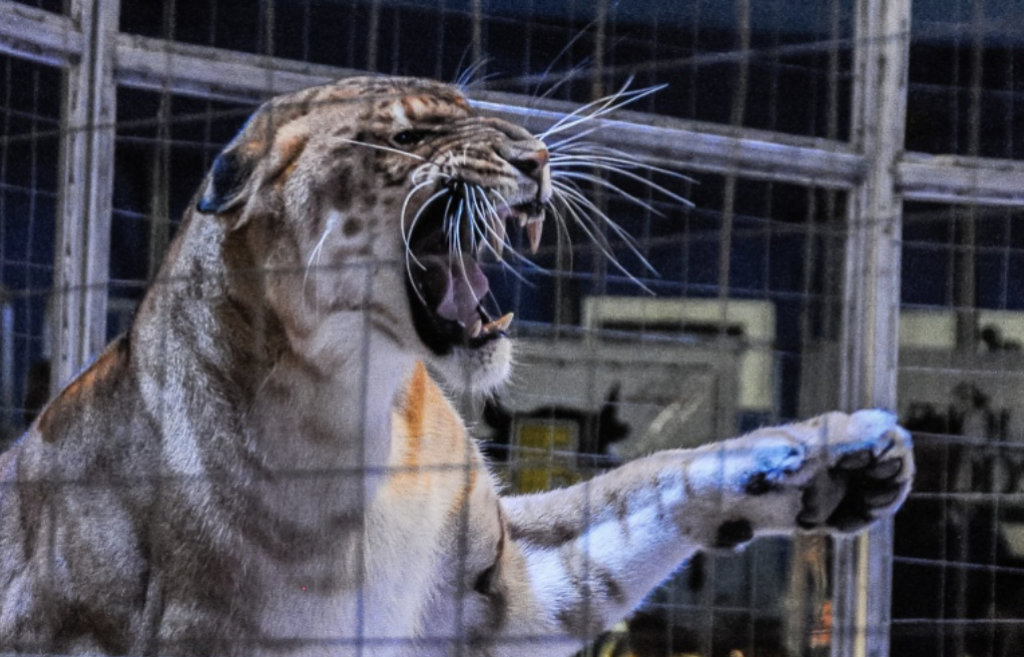
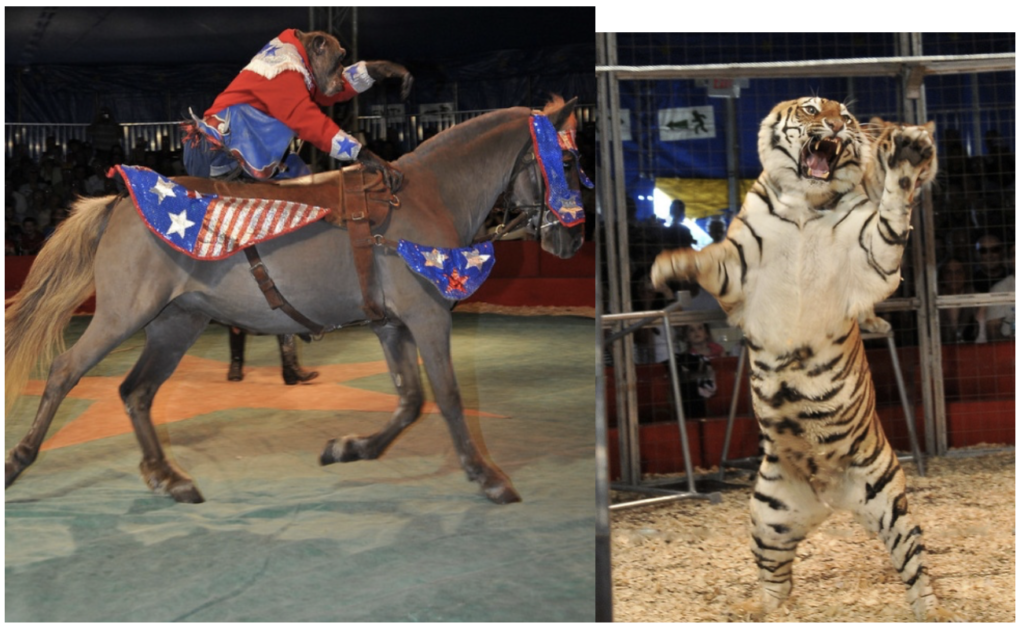
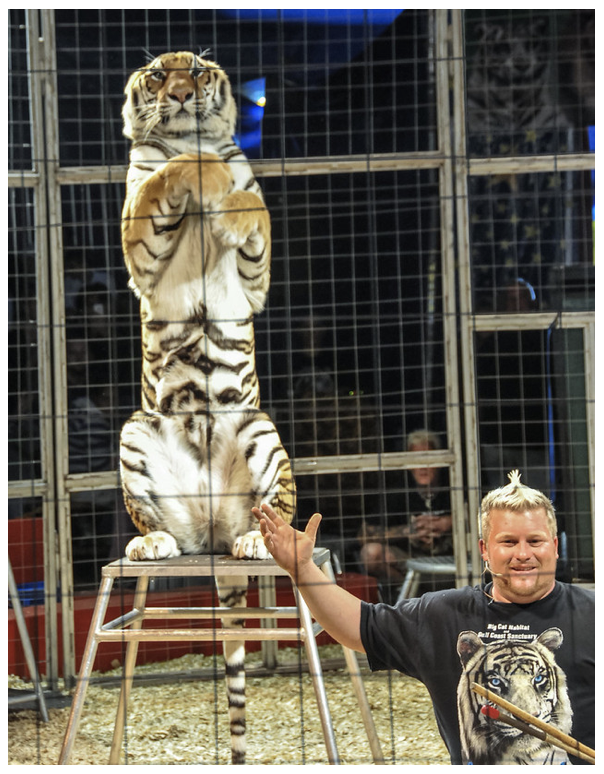
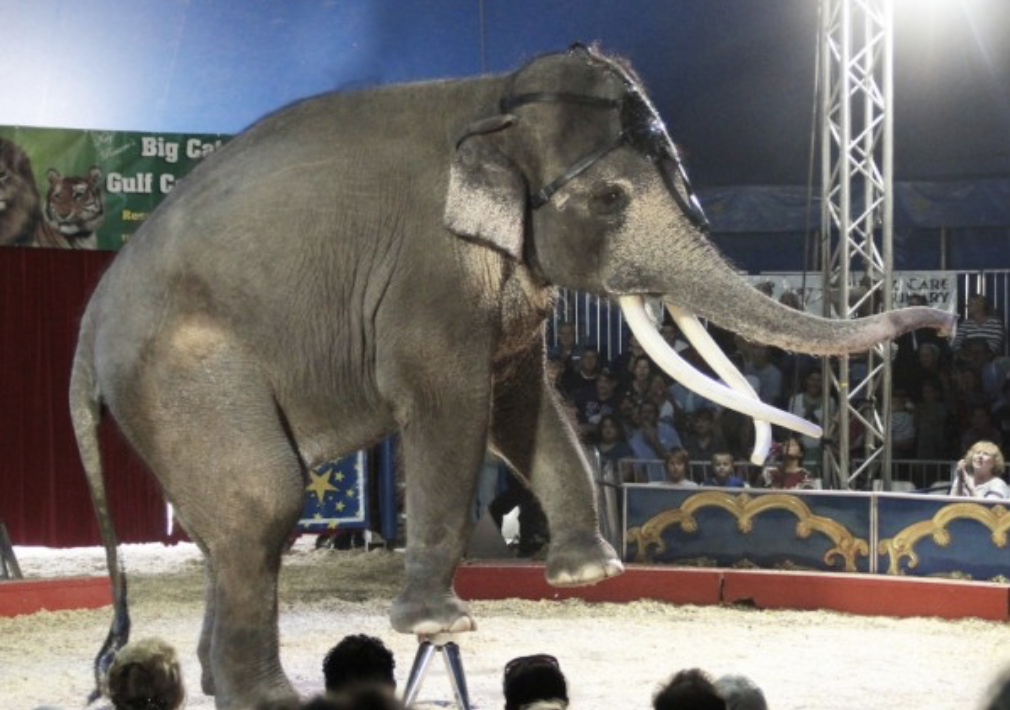
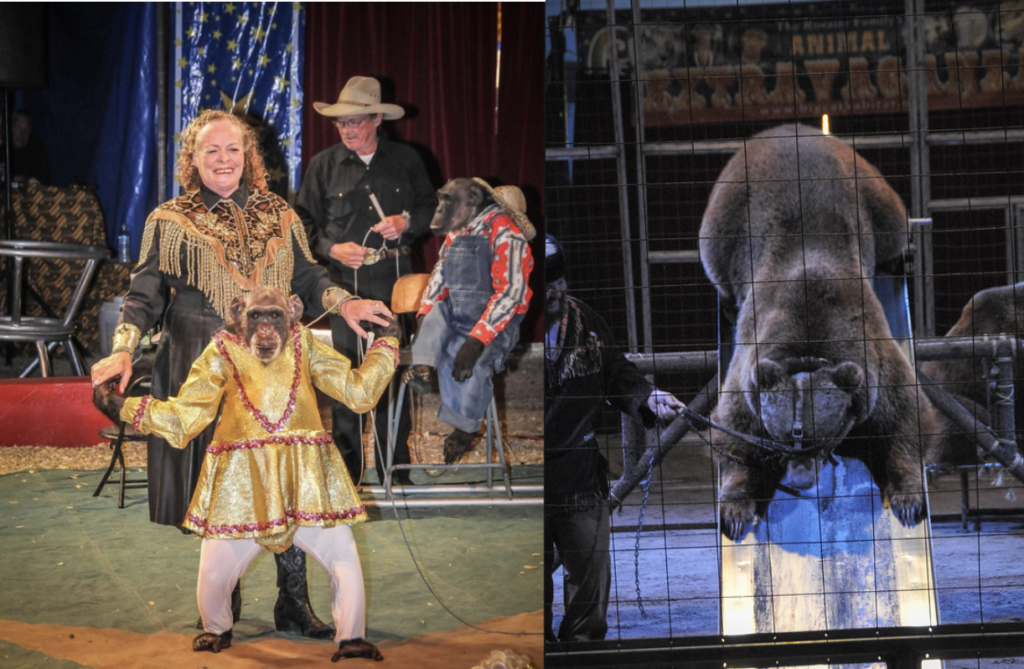
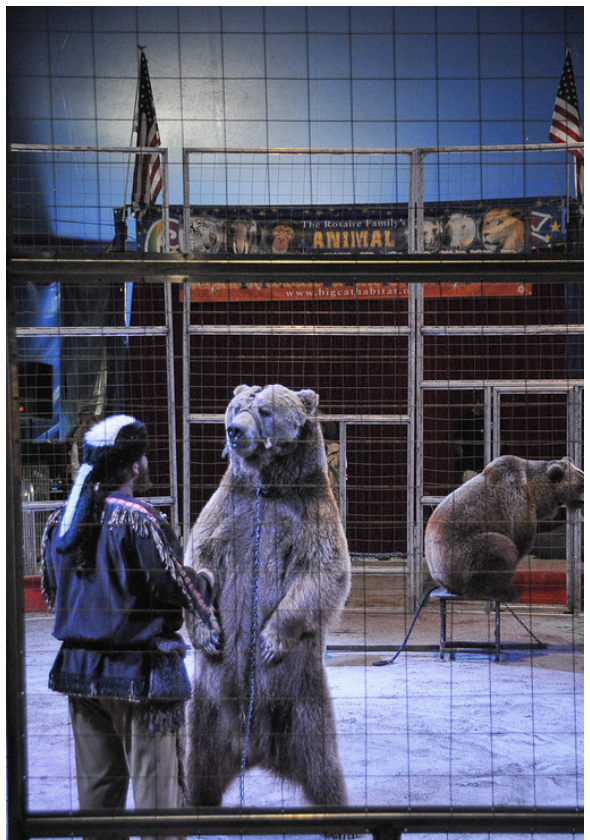
Traveling Animal Shows
Unlike any legitimate sanctuary, Big Cat Habitat continues to haul their big cats and bears around the country to perform for profit at shrine circuses and fairs. They also drive a trailer full of tigers through screaming crowds at local parades. A Born Free study concluded that big cats in traveling circuses spend 94% of their time in their cramped travel transport cage without an opportunity for exercise or enrichment.
This video shows a trailer of pacing, distressed tigers from Big Cat Habitat being driven through the flashing lights and blasting music of the Venice Holiday Parade in Miami. They’ve repeated this exploitative stunt for several years in a row at the Venice Parade, as well as at the Downtown Sarasota Christmas Parade. The banners on the trailer claim “love and respect” for animals, but nobody who truly respects big cats would drag them through the streets as a living parade float. This is incredibly stressful for big cats.
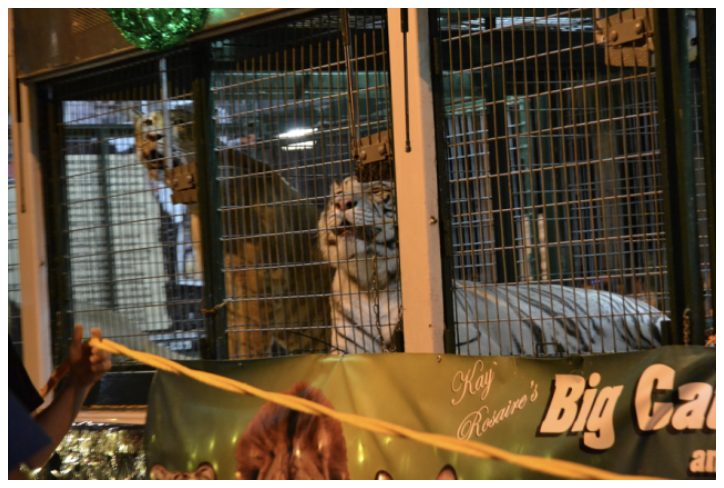

Big Cat Encounter Fair Show
Throughout the summer, Big Cat Habitat travels the fair circuit with their big cats in order to present Clayton Rosaire’s “Big Cat Encounter” circus show, advertised as an “educational program.” A promotional video of the entire show includes some truly bizarre and disrespectful “demonstrations,” including Clayton repeatedly yanking hard on a tiger’s tail for laughs, playfully slapping a tiger with its own tail, and making a “rare” white tiger sit up on a spinning disco ball and “pray for the wild tigers.” The cats frequently flatten their ears and grimace in fear whenever Clayton approaches them with his whip. The only thing these shows “teach” the public about tigers is that it’s okay to dominate and humiliate them for our entertainment.
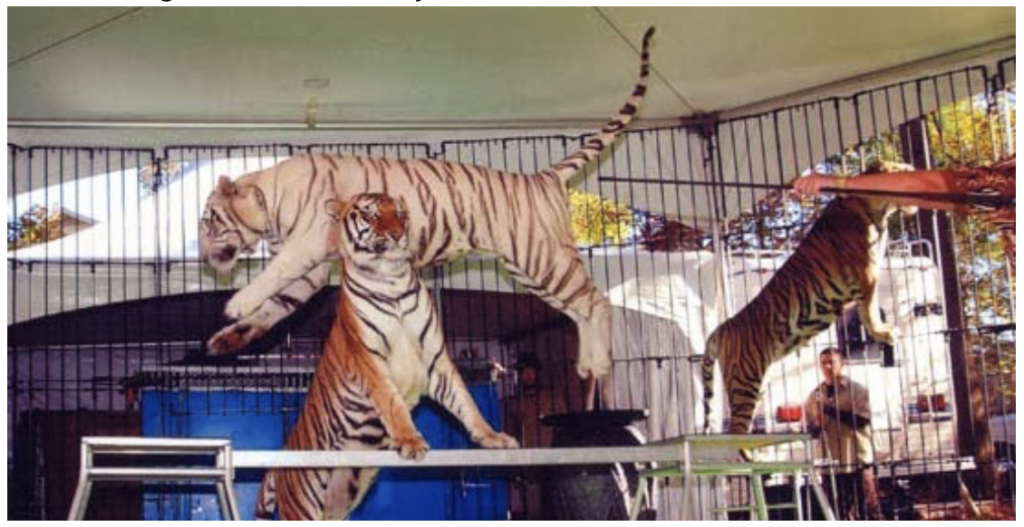

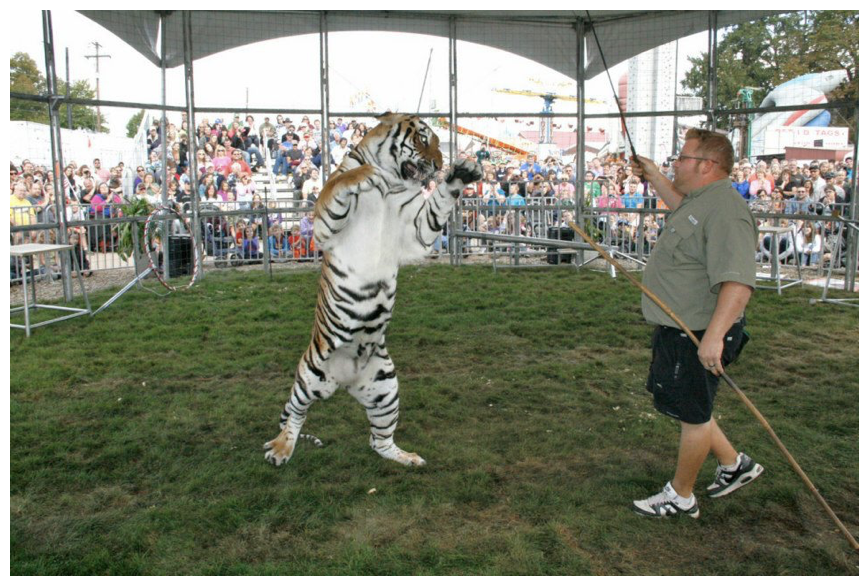
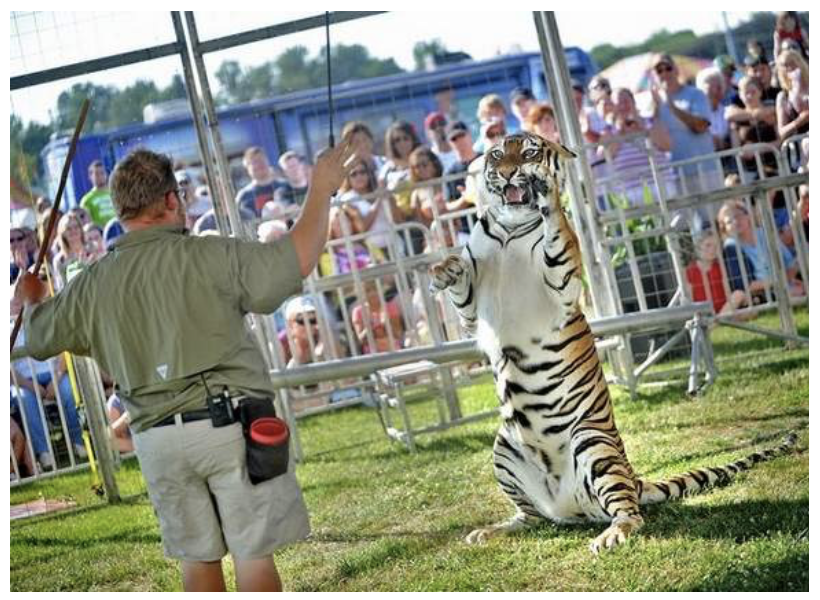
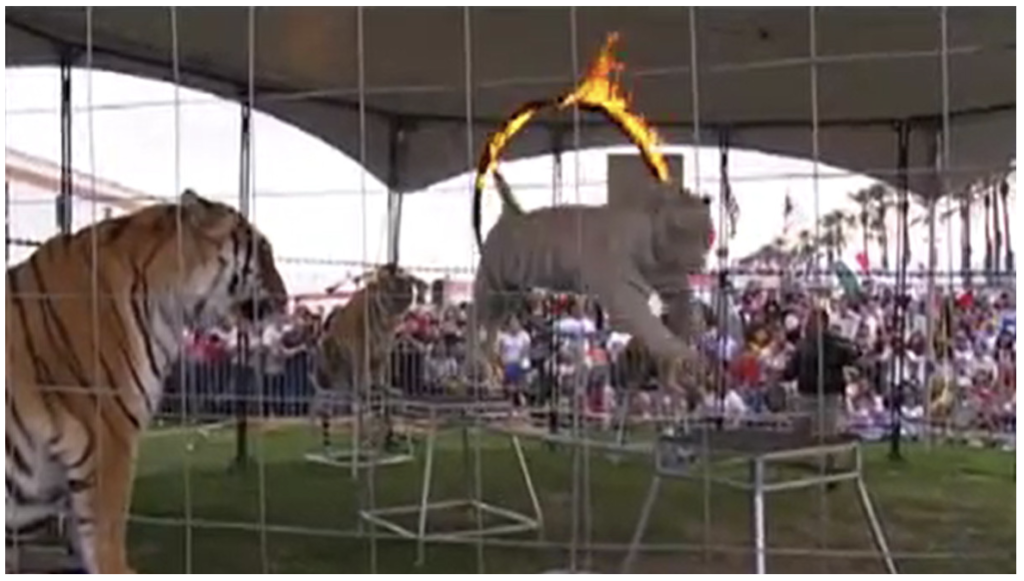
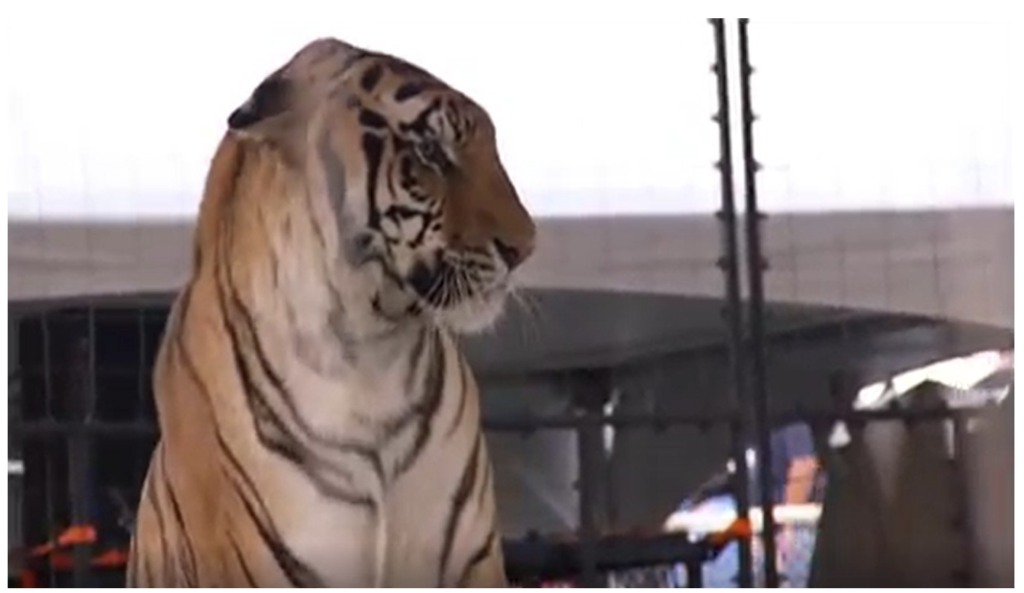
A tiger flattens his ears while Clayton waves a stick over his head to command him to “sit up” during a fair show.
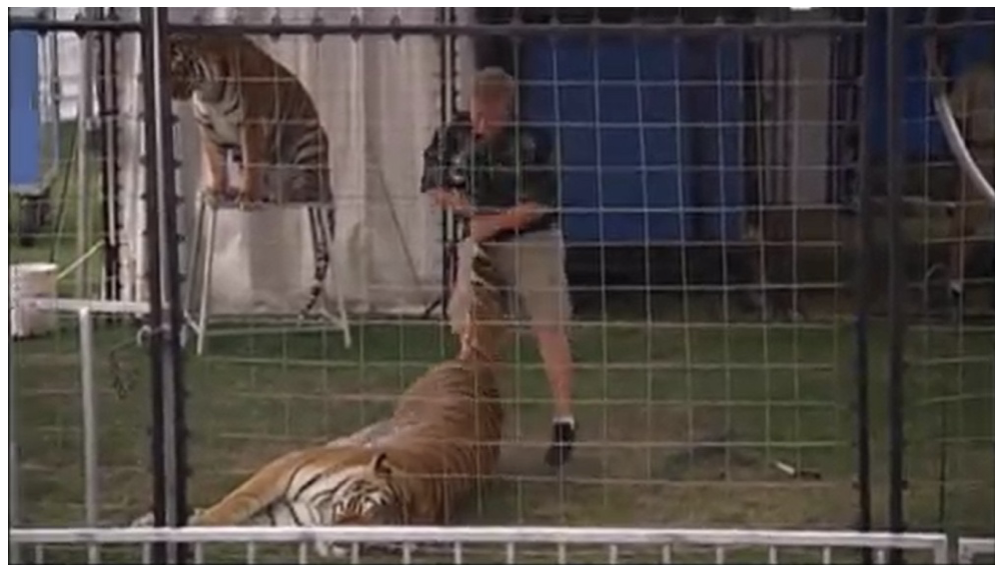
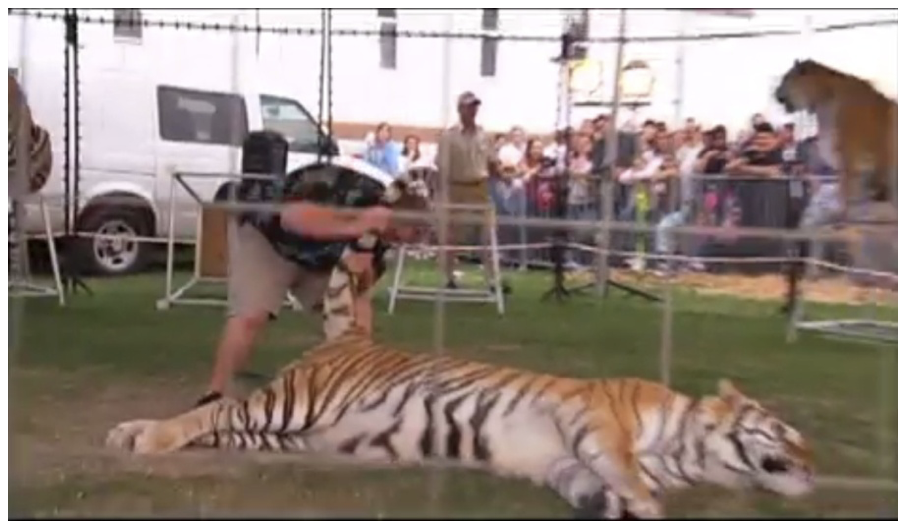
In one part of the act, Rosaire repeatedly pulls on a tiger’s tail hard enough to lift the cat’s hindquarters off the ground, then slaps the tiger with its own tail for laughs.
In this interview, Clay Rosaire says that the cats travel the fair circuit for the equivalent of six months each year. Each fair usually lasts about a week and the group travels about 200 miles to get to the next location. The reporter also noted that when the cats weren’t performing, they “slept in cages, which were only slightly longer than their body length but “government approved.”
Rosaire’s Bears
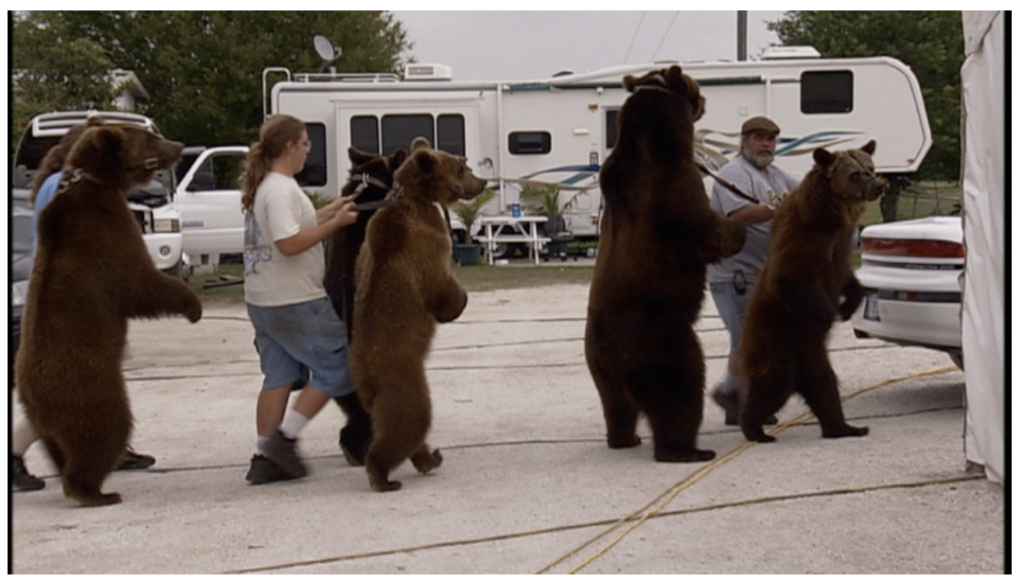
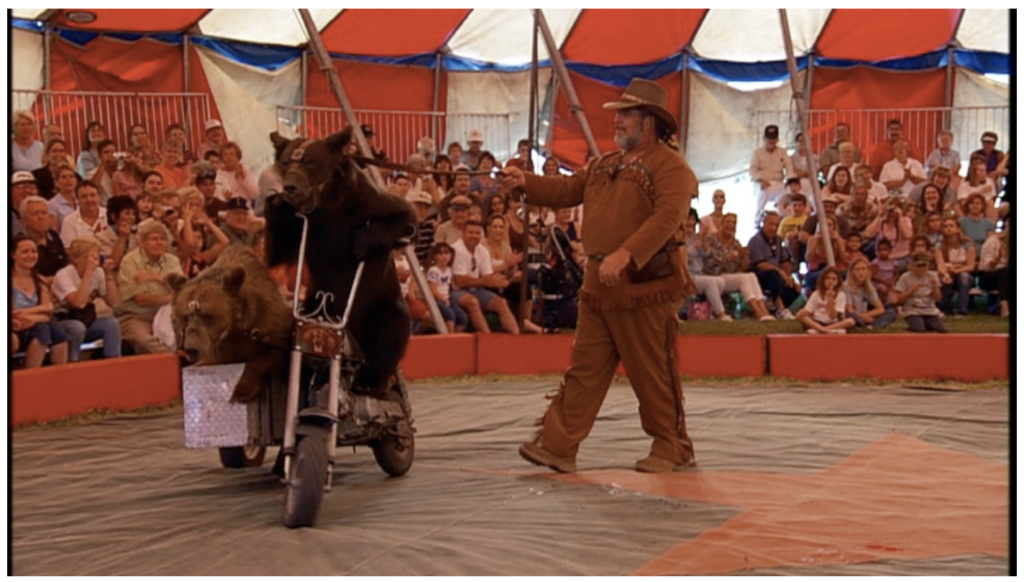
Rosaire’s Bears is the traveling bear act owned and operated by Frederick and Kay Rosaire. It is based from a different facility which is not open to the public and which has been cited for multiple severe and repeat violations of the Animal Welfare Act. These violations include housing bears in rusty steel shipping containers too small for the bears to escape their own waste; failing to provide bears with clean water and adequate cooling for 115 degree temperatures, and having inadequate fencing, which resulted in the death of a bear after being mauled by a neighboring bear housed in an adjacent enclosure. The bears frequently perform at Big Cat Habitat and continue to be hired by Shrine Circuses across the country.
In April 2018, a spectator filmed a brown bear named Chopper urinating in fear during a performance of “Rosaire’s Bears” at a Shrine Circus in Bangor, Maine. The bear then drank his own urine, an unnatural behavior believed by experts to be an indicator of poor health or psychological suffering.
[The Rosaires] yank their leashes, making the bears walk on their hind legs like humans while drinking from bottles, and leap up onto barrels and chairs. But one of the bears, believed to be named Chopper, doesn’t listen to his trainer’s commands. Instead, he urinates, which can be a sign of extreme fear. Later, he does it again.”
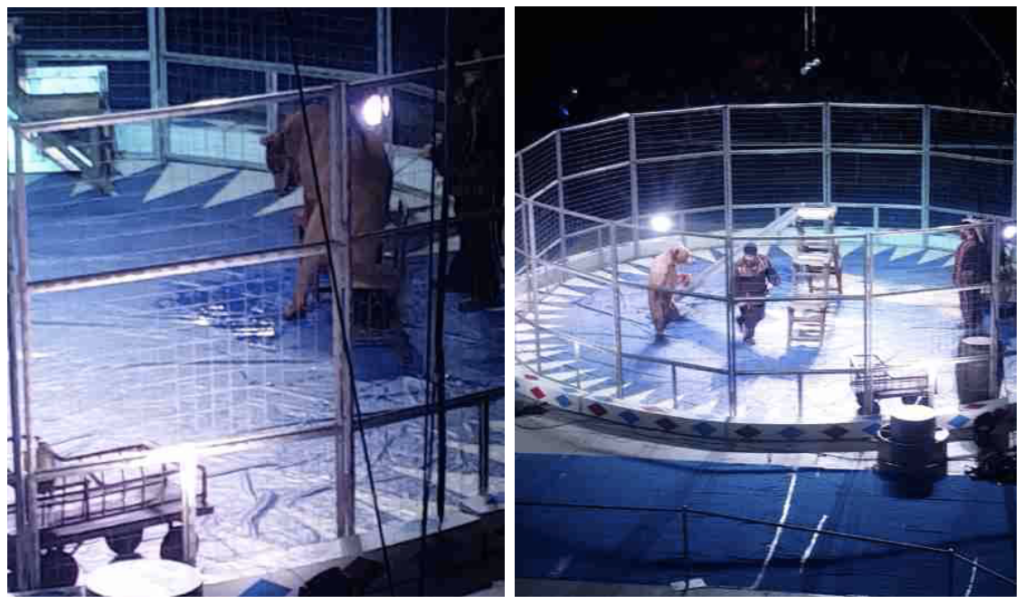
One of Frederick Rosaire’s bears is seen urinating on the floor during a 2018 circus performance.
Captive wildlife specialist Debbie Metzler reviewed the video and stated:
“This is run-of-the-mill for circus acts. The two bears, believed to be Indian and Chopper, were almost constantly slapped, poked and jabbed. They were pulled hard by leads, and coerced to walk and sit like humans, push carts and climb ladders, which are all things that can lead to muscle and joint pain, injury and even chronic psychological distress. A bear expert reviewed that video, and said that the urination was likely a severe distress response to being forced to perform uncomfortable acts. And drinking urine is also an abnormal behavior, and it could be caused by some underlying physiological concern like nutritional deficiency or dehydration. It could also be a coping mechanism, as a result of psychological suffering.”
DJ Schubert, a wildlife biologist with the Animal Welfare Institute (AWI), told The Dodo that bears “would never naturally walk in an upright position on two feet nor would they walk backwards in the wild. To train a bear to perform such an unnatural act requires the use of cruel methods.”
When the bears aren’t performing in the ring, Rosaire pimps them out for $10 photo-ops with circusgoers. He has been cited by the USDA multiple times for doing these photo sessions in an unsafe manner.
Chance the Chimpanzee
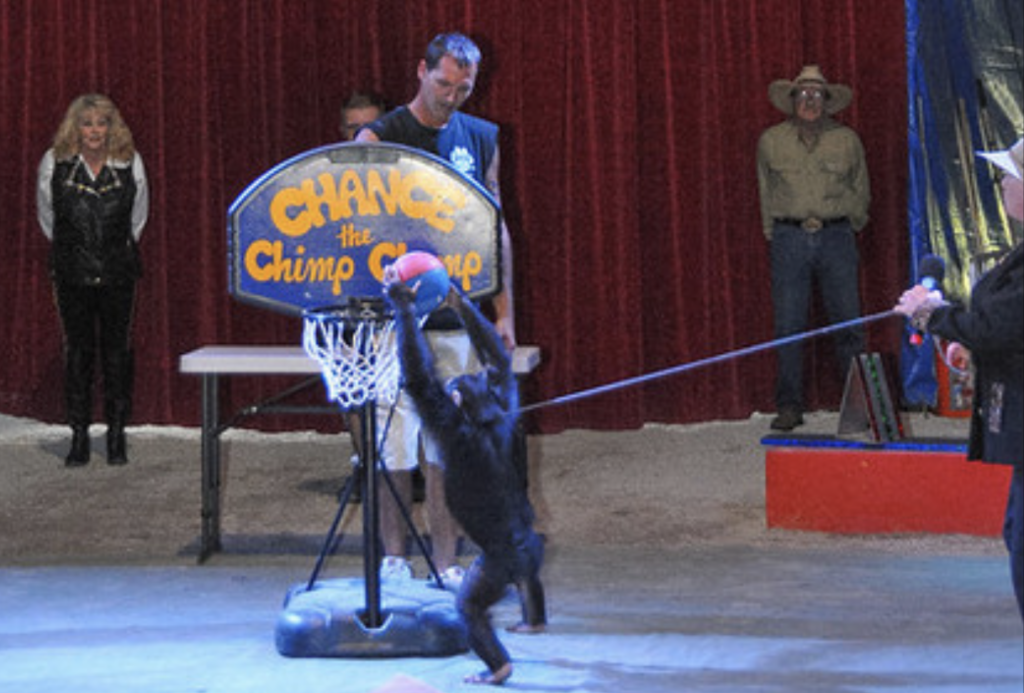
Chance, formerly named Aiden, is a young performing chimpanzee owned by Pam Rosaire, co-owner of Big Cat Habitat and the last remaining person in the US who actively trains chimpanzees for circus acts. Pam often dresses Chance in human clothing and leases him out for movies and commercials for profit. This is something a real sanctuary would never do, especially because studies have proven that using chimps as showbiz props is bad for conservation efforts. Pam claims that she “rescued” Chance, but an excellent blog post by chimpanzee advocate Dawn Forsythe reveals his real history:
“Tropicana Orange Juice recently unveiled a new TV ad. The ad co-stars actress Jane Krakowski who mugs it up with a baby chimpanzee. Hundreds of people immediately went to Tropicana’s Facebook page in angry protest, demanding that Tropicana take the ad down. Within 24 hours, on a Saturday night, the Tropicana public relations folks were peddling a fantasy about how they were helping poor Chance, a “rescued” chimpanzee.
Bullshit.
Chance’s real name, before he got a name change in the grand Hollywood tradition, was Aiden.
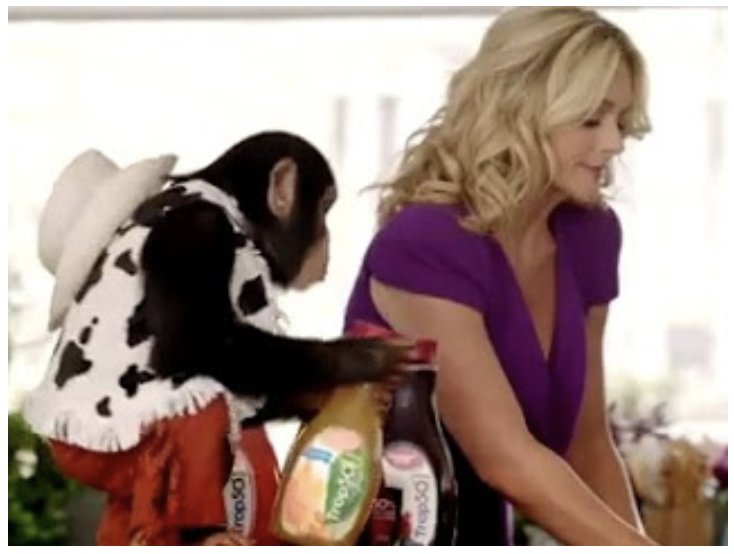
Aiden/Chance and Jane Krakowski in the Tropicana ad
A family bought him as an infant from Savannahland, but decided to dump him. A renowned chimp welfare advocate tried, but failed, to convince them to send Aiden to an accredited zoo or sanctuary. The family refused. Instead, they sold him to Pam Rosaire, in order to recoup some of the money they spent on him. Pam and her sister Kay call themselves a sanctuary, but Big Cat Habitat continues to stage chimp shows and market their chimps for show biz gigs.”
Big Cat Habitat rented out Chance the chimpanzee and “Handsome” the lion to be used in the hit 2013 film The Wolf of Wall Street. Bob Orabona of Friends of Animals interviewed Pam Rosaire about Chance and his appearance in the film. He writes:
Pam Rosaire, of the notorious Rosaire family of animal circus trainers, owns and trains Chance, the chimp in The Wolf of Wall Street. Pam boasts of a living made teaching dangerous “trick-riding” stunts to chimps on horseback in circus shows, using them in commercials, films and events, and even claims to have breast-fed a newborn chimp in 1979. Pam currently owns six chimpanzees — once they turn 8 years old, they can no longer be used in show business, so young ones must be continually acquired.
I spoke at length with Pam via telephone.
Chance is a third-generation captive-born chimp, taken from his mother at infancy.
Now 4 years old, Chance was 7 months old when Pam purchased him from a couple who bought him from a breeder in Missouri for $65,000 but soon decided they could not keep him. Missouri allows breeding and selling of chimps.
Pam started making money off of Chance immediately by taking him to agencies and booking him for commercials, events, and now, a Hollywood film.
Pam told me it took her three weeks to teach Chance to roller skate — something required of his role in the film. “He’s very trained and does what he’s told and does it right.” Pam says, “I’ve raised all my chimps from little babies. I’ve been working with chimps since I’m 7 years old.”
Pam elaborated on how she gets rambunctious young chimps to “do what they’re told.”
“I’m the matriarch and they do what I tell them to do. I make them listen. They’re very childlike. If they don’t listen, I make them sit down and do a time out. That’s the worst thing for a chimp, to force him to sit still in a chair alone until he listens. Chimps are very fidgety, so sitting still in a chair is something they don’t like.” Pam said it only took about one hour on the set to film Chance’s scenes with DiCaprio.
Bob Ingersoll, a primatologist who appears in the documentary Project Nim, was disgusted that a real chimp was used in the film and said that with current computer graphics technology, “No animals need to be exploited in films, ever again.” Bob explains Pam’s method of training. “What she’s doing is withholding affection and reassurance, something you’d never do to an infant. It’s wrong and creates long term psychological damage. Chimps don’t naturally withhold affection and reassurance like that long term; they have a tiff and get over it quickly. That’s how she trains him–withholding the emotion and affection.”
News Articles
Ringling decision doesn’t please some animal welfare groups
By MARTY CLEAR | March 06, 2015 | Bradenton Herald
If anyone should be happy about the announcement Thursday the Ringling Bros. and Barnum & Bailey Circus will stop showcasing elephants, it would be people whose work involves watching out for animals
Or so one might think.
In fact, the decision saddened some animal-welfare people. Others say they’re not quite sure they believe it.
“I think it’s very sad,” said Kay Rosaire, founder and owner of Sarasota’s Big Cat Habitat, a nonprofit animal sanctuary.
“They fought the good fight for a long time.”
In Rosaire’s view, the circus and its parent company, Palmetto-based Feld Entertainment, caved in to “animal rights extremists” who really aren’t concerned with animals at all.
“They don’t care about animals,” Rosaire said. “It’s all about the money.”
What’s more, she said, Feld gave those groups a victory in one battle in a long-term war.
“I think this is just the tip of the iceberg,” she said. “It’s just matter of separating people from animals. They’re going to get rid of guide dogs and there will be no horseback riding and no pets.”
One group Rosaire is talking about is People for the Ethical Treatment of Animals, which has been protesting animal treatment at Ringling Bros. for decades.
PETA officials said Thursday the decision is not the overwhelming game-changer Rosaire says it is.
“We’re hoping they’re sincere,” said Brittany Peet, PETA deputy director of captive animal law enforcement, speaking from her office in Washington, D.C. “But if Ringling is sincere, the time to retire these animals is today.”
Peet said PETA is skeptical about Ringling’s announcement but declined to say why.
“There are reasons,” she said. “I do not want to put them out in the world and suggest them. It’s difficult to trust an organization that engages in this type of behavior. After 35 years of advocating against Ringling Bros., we’re very wary of this shady company.”
Feld officials did not respond Thursday to repeated calls and other messages requesting interviews. Feld media representatives said the officials were busy trying to deal with a huge number of interview requests after the announcement.
Peet and other PETA officials have claimed Ringling Bros. mistreats elephants and other animals. Peet even used the word “torture.”
That’s ridiculous, Rosaire said.
“Elephants are worth a huge amount of money,” Rosaire said. “An Asian elephant is worth about a half a million dollars, I think. Nobody’s going to abuse them.”
Besides, she said, controversy about alleged animal abuse has put Ringling Bros. and other circus under a microscope.
And she noted Ringling got almost $25 million in settlements from animal rights groups that had sued Ringling for allegedly abusing its 43 Asian elephants. That suit was dismissed, Ringling sued the rights groups and won lucrative settlements.
“That tells you everything you need to know right there,” Rosaire said.
The bigger issue, she said, is elephants and other circus animals are endangered and mistreated in the wild. Elephants are often victims of poachers, for example. They’re better off, she said, in humane captivity where they can be fed and cared for by keepers. Elephants and tigers could become extinct if they’re not allowed to be bred in captivity, she said.
Peet said PETA would not stop protesting until Ringling Bros. eliminated all animals from its circus.
Sarasota chimp and lion have roles in ‘Wolf of Wall Street’
By IAN CUMMINGS
Posted Dec 26, 2013 at 6:13 PM
Sarasota Herald-Tribune
Moviegoers watching the new Leonardo DiCaprio film “The Wolf of Wall Street” will see two locals among the cast: a chimpanzee and a lion who live at a Sarasota County wildlife sanctuary.
Chance, a 4-year-old chimpanzee, and Handsome, a lion, play exotic pets brought into the offices of an out-of-control stockbroker in the movie. In real life, the two are among several working animals residing at the Big Cat Habitat animal sanctuary, 7101 Palmer Blvd.
Kay Rosaire, owner of the sanctuary, said her sister raised Chance from an infant and accompanied him to the movie set, where DiCaprio and Chance spent a lot of time together.
“They really liked each other. They worked well together,” Rosaire said. Chance even learned to roller skate for the part, Rosaire said, beginning on one skate before adding the second after about three weeks.
Handsome was later added to the cast because the trading company featured in the film used a lion as its symbol. The movie is based on the true story of Jordan Belfort, who became a wealthy stockbroker before becoming entangled in federal investigations of crime and corruption.
Money earned from appearances by the sanctuary’s lions, tigers, and birds in films and commercials goes to support the nonprofit, which also houses many non-working animals, Rosaire said. “They’re professionals. They support the non-working animals.”
The animal rights group People for the Ethical Treatment of Animals has criticized the use of Chance and other great apes in such movies. The group is circulating a petition asking DiCaprio to not use them in films, claiming that the apes are often mistreated during and after their film careers.
‘Big Cat Habitat’ show comes to I-X Indoor Amusement Park
Posted Mar 26, 2010 | Cleveland.com
By Chuck Yarborough, The Plain Dealer
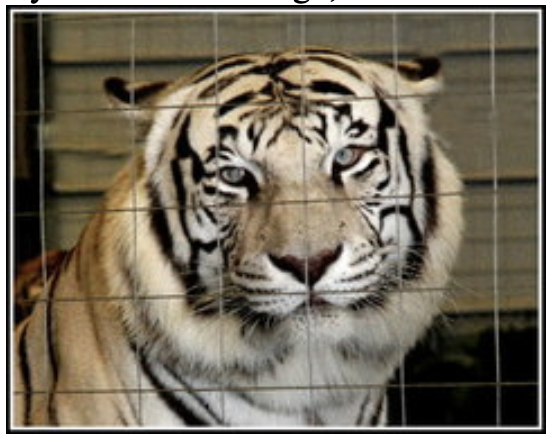
RICHARD CZINA / BIG CAT HABITAT Big cats don’t purr in the conventional house-cat sense, but they do make a nice “chuffing” sound when they’re happy, said trainer Clayton Rosaire, who brings his furry friends to the I-X Indoor Amusement Park this year.
PREVIEW
Big Cat Habitat at the I-X Indoor Amusement Park
When: Now through Sunday, April 18.
Where: International Exposition Center, 6200 Riverside Drive, Cleveland, near Cleveland Hopkins International Airport.
Admission: $19; $16, children under 48 inches tall; $9, seniors 60 and older on weekends (free on weekdays); and free, kids under 3. For a schedule: ixa musementpark.com. Call 1-800-897-3942.
Co-workers who bite your head off when they’re having a bad day are common in this ol’ workaday world. But for most of us, it’s just a figure of speech. Not for Clayton Rosaire.
That’s because the Sarasota, Fla.-born descendant of a European circus family works with big cats — lions, tigers and even a rare “liger,” a combination of the two.
“They’re really intelligent animals, and they can be very loving, too,” Rosaire said in a call made to his family’s exotic animal preserve, the Big Cat Habitat and Gulf Coast Sanctuary in Sarasota. “You just have to remember that not everybody has a good day all the time, and every once in awhile, they may try to eat you.”
Not that there’s any need to worry if you’re headed to the I-X Indoor Amusement Park during the monthlong run that opened Friday and want to catch his “Big CatHabitat” show.
His buddies will be under control. Besides, he’s going to be the hors d’oeuvre closest to them.
But Rosaire’s laugh-laden show — he’s one of the only exotic animal trainers to combine comedy and creatures that can ingest you — also focuses on education. And one of the things about which he wants to educate folks is that these are not just big kitties.
“People are funny,” Rosaire said. “They have what I call ‘the fur factor.’ What it is, is you take any huge killer, meat-eating animal like a lion or a tiger or a grizzly bear, and people go, ‘Awww, I want to give ’em a hug.’ And it’s all because of the fur.
“You take another couple of huge killer animals, like say a crocodile or a great white shark. You’ll never hear anybody say they want to give a crocodile a hug. You’ve never heard anybody say they’re gonna buy a great white shark and keep it in the pool and their kids are gonna swim with it on the weekend.
“But you get these crazy people who think they’re going to have a tiger living in their basement, and it’s going to be a family pet. It’s the fur factor,” he said.
That fur factor is one reason the animal population at the sanctuary keeps growing. Right now, that equates to 46 big cats, 17 bears and all kinds of monkeys, tortoises, lemurs and more. Which begs the question: How do you feed such a massive menagerie?
“Carefully. Very carefully,” Rosaire said.
You don’t want the tab, either. Rosaire said that several local grocers help with produce, fruits and such for the bears, primates and tortoises. But the meat for the big cats has to be purchased. When the sanctuary opened in the late 1980s with only eight big cats, the annual food cost was $70,000. On the plus side, that did include vet bills and vitamins, he said.
And that’s another reason why the population keeps growing. Just as kittens grow into cats, cubs grow into . . . well, big, furry eating machines.
“None of our animals were born here,” Rosaire said. Some of the animals come from owners who obtained them illegally and have to get rid of them, and some come from owners whose acquisition was legal but have discovered just how flippin’ much a tiger can eat.
Still, Rosaire loves his charges, and he’s pretty sure they love him. As a matter of fact, they’re just one big, happy, furry family.
“If they know they’re in your permanent family and that they’re going to spend the rest of their lives with you, they really enjoy seeing you. It gives ’em something to look forward to every day,” Rosaire said.
“My little female liger, she can smell me walking by the building before she can even see me, and she yells at me to come and say hello to her.”
Mia — the liger — is one of the critters you’ll be able to see at the I-X Center.
“I’m going to be bringing about eight animals with me,” he said. That would be a white Bengal tiger named Samson; a couple of female tigers named Noelle and Kira; an African lion named Handsome; and a couple of white tiger cubs — 7-month-old Barry White Tiger and 5-month-old Vanna White Tiger.
“Hey, you gotta work with what you have,” said a laughing Rosaire when the names of the two cubs produced an expected groan.
But the star of the show is likely to be Conan. At 750 pounds, he’s one of the largest performing tigers in the world, Rosaire said. Don’t tell the others, but Conan is his favorite.
“Conan is kind of like my brother,” Rosaire said. “He’s 14 years old, and I just turned 30. Me and Conan have been together for the past 14 years, half my life.”
By the way, Conan’s age is about double the average of a tiger in the wild. Female lions live a little longer, but not much. For male lions, it can all be over before their first birthday.
“That’s because every time a new male lion comes in and takes over a pride, they kill all the male offspring of the last one,” Rosaire explained.
“That’s why they say it’s a jungle out there.”
Free big cat show looks to educate
By Keith Gushard
Aug 22, 2007
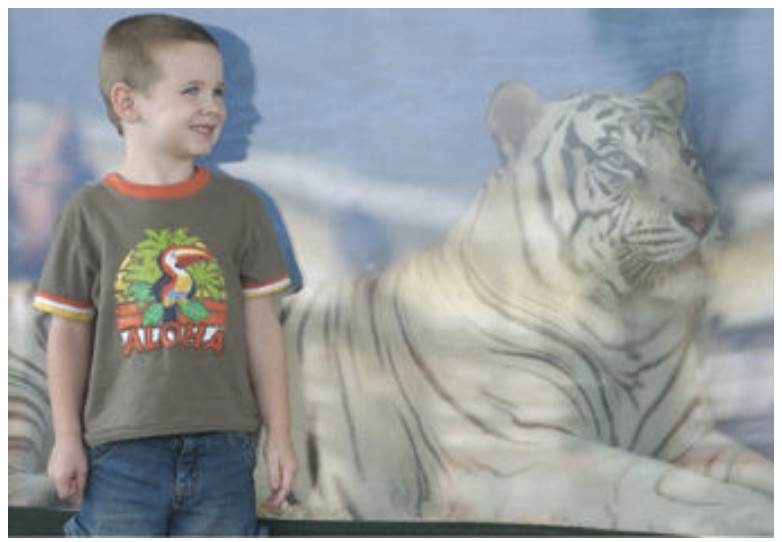
Matthew Nale, 4, of Saegertown poses for a Polaroid picture with the white tiger after the big cats show at the Fair. Clayton Rosaire announces at the end of each show for $10 anyone can have their photo taken, perfectly safely, with the white tiger who poses in a Plexiglas case. Proceeds, according to Rosaire, go to help save more animals like these tigers.
Meadville Tribune
WEST MEAD TOWNSHIP — A soft, low rumble rolled past the steel bars as his blue eyes followed the movements of people inside the darkened tent.
“That’s his way of greeting you,” Clayton Rosaire said of Samson, who was almost purring like a kitten.
But Samson isn’t a house cat — he’s a nearly 700-pound male white tiger with piercing blue eyes.
Samson and four other orange/black tigers are part of Kay Rosaire’s Big Cat Encounter of Sarasota, Fla., on display this week at the Crawford County Fair.
There are three free shows daily at the fair. This is the show’s second year in a row at the fair.
“We try to do a show that’s educational,” said Kay Rosaire, an animal behaviorist and educator. “We explain about their habitat and lifestyle.”
Rosaire and her son, Clayton, operate Big Cat Habitat and Gulf Coast Sanctuary, a non-profit sanctuary for tigers, lions, bears and other wildlife. They tour with some of the animals about 15 weeks each summer.
“We try to raise awareness about the animals and show what the animals can do,” Clayton said.
“We show their natural behaviors — sitting up, jumping and their athletic ability like standing on their hind legs,” he said.
There are fewer than 3,000 Bengal tigers in the world and only about 500 Siberian ones, Kay Rosaire said.
Samson is a rarity because of his blue eyes and white coloring, said Clayton. “He’s not an albino because his eyes are blue, not white.”
However, white tigers are only found in captivity. They can’t survive in the wild because their color gives them away, said Kay Rosaire.
The animals are large and powerful, Clayton said. A female tigers weighs about 400 pounds while a male like Samson can weigh in at around 700 pounds.
Clayton has been doing the act for about 10 years, taking over for his mother, Kay.
He’s been injured by the animals a number of times. While he’s done it, he no longer sticks his head inside the open mouth of a tiger because it’s too dangerous.
“I’ve had plenty of hospital visits,” Clayton said with a laugh. “When you’re working with large animals there’s a risk. If something happens it’s your fault. They’re always going to be a tiger. You have to respect that and read their mood.”
Caring for the animals is a 24-hour a day job, he said.
“We’re always working with them,” he said. “We have to feed and water them and give them time to play.”
Clayton said the only thing that will halt a show is rain storm with thunder and lightning. That’s to protect both the animals and the people in the audience, he said.
YOU CAN GO
Kay Rosaire’s Big Cat Encounter is holding free shows at the Crawford County Fair daily at 2, 6 and 8 p.m. The shows are in a tent near the Youth Show Arena.
DID YOU KNOW?
Kay Rosaire, who was born in England, is no stranger to northwestern Pennsylvania.
She’s a 1969 graduate of Fort LeBoeuf High School in Waterford.
Her father, Derrick Rosaire, had a comedy horse act called “Rosaire and Tony the Wonder Horse.” The act had toured the U.S., including appearances on the Ed Sullivan Show, a television variety show. The act played Erie several summers and her father liked northwestern Pennsylvania so much he bought a farm near Waterford.
After an injury forced Derrick Rosaire to stop performing, he became curator of the Erie Zoo in the early 1960s.
Kay Rosaire carries on circus tradition
Sarasota Herald-Tribune
By NANCY CHAPMAN / CORRESPONDENT
Posted Jan 5, 2006 at 12:01 AM
Kay Rosaire knows that she could sell her land east of Interstate 75, take her millions and go live the easy life in Alabama. She could even take all her animals with her.
That’s 17 lions and tigers, 14 bears, a camel, a bobcat and 12 dogs, by the way.
But Rosaire likes Sarasota, and rather than packing up and moving the Big Cat Habitat and Gulf Coast Sanctuary, Rosaire and her new board of directors have developed a five-year strategic plan to upgrade.
First is a new bear habitat, which they expect to have completed within a few weeks.
Later, they’d like to build a geodesic dome to host more people for their shows and provide safe haven for big animals — hers and other people’s — during a hurricane.
Other ideas include a gazebo between the tiger and lion enclosures, with thick glass on either side, so photographers and artists can view the animals as they behave in natural surroundings.
For now, Rosaire is doing what she does — rescuing big animals that were born in captivity and can no longer be cared for by their owners.
The bobcat is an exception: He was found as a kitten under a car and rescued. Now that he’s accustomed to humans, he can’t be set free.
Like the others, he’s set for life: loved, nurtured and provided for.
Rosaire is the eighth generation of a circus family. Her father, the late Derrick Rosaire, performed in circuses, theaters and rodeos, and also trained movie animals, including Gentle Ben the bear.
She founded the sanctuary in 1987, and, despite maintaining a relatively low profile, the place has a legion of fans.
That was made obvious Saturday. Rosaire and her family weren’t planning to hold one of their weekly demonstrations on New Year’s Eve day, but they got so many phone calls that they changed they minds. With no advertising and short notice, about 300 people showed up.
It wasn’t just like you’d see at a circus; it had a family atmosphere to it. Rosaire sat next to the cage with a microphone, bantering back and forth with her son, Clayton Rosaire — the youngest lion and tiger trainer in North America, she said — as he put five tigers through their paces.
Before that, her brother, Derrick Rosaire Jr., led his bears through their show, suffering many kisses from Peter, a bear whose size eclipsed the burly man’s.
It didn’t just entertain the crowd, it provided sustenance for the animals — another new policy for the sanctuary is a requested donation of $5 per person for the show.
The 300 people packing the show meant that the family had more money to feed the animals and to continue upgrading.
“I’m continuing the legacy my dad started,” Kay Rosaire said. “I can’t imagine not being here.”
The Big Cat Habitat and Gulf Coast Sanctuary is located at 7101 Palmer Blvd. For more information, call 371-6377 or go to bigcathabitat.org.
The Wild Kingdom of a Lady Lion-Tamer
By Robin Finn | The New York Times | June 23, 2006
Manorville
JUST off Exit 70 of the Long Island Expressway on a nondescript swath of flatland, Kay Rosaire, arguably Suffolk County’s most exotic summer resident, lives in a modest trailer tucked away on the perimeter of the Long Island Game Farm. She dresses the part: animal print shirt, lion-head ring, safari vest. Even her patio umbrella is leopard print. And she is not summering alone.
Ms. Rosaire, 57, keeps cats on Long Island, the same type of kitty that took a tragic bite out of one-half of her more famous contemporaries, Siegfried and Roy, in Las Vegas awhile back. The type that took a 200-stitch bite out of her in 1991, a breach of trust that briefly caused her to rethink her career and rue the day her only child, Clayton, decided to follow in Mom’s footsteps and train tigers(and lions and bears).
This summer Clayton is in Vegas, picking up where Siegfried and Roy left off. His mother is, with six of her furry friends, spending her fifth consecutive summer on Long Island, performing two shows a day — three on weekends — in the hope of keeping her main mission in life, Big Cat Habitat and Gulf Coast Sanctuary, a nonprofit organization, alive in Sarasota, Fla.
Vicarious thrill-seeker alert: She has popped her head inside the gaping mouth of a Bengal tiger and ridden bareback on a lion named Leeds that once saved her life when a female tiger pounced on her in midperformance in Montreal. She also owned Tyler, the lion that roared on cue in Tim Burton’s fantasy film “Big Fish” in lieu of swallowing up the actor Ewan McGregor’s cranium.
Sadly, Leeds died at 26, and Tyler at 23, a ripe, old age for any lion, movie star or not. But Ms. Rosaire, lady lion tamer, is still right here in the flesh in every Long Islander’s backyard. Incongruous, yes. Insane, no.
The tiger lady is, much like her cats, an endangered species. People for the Ethical Treatment of Animals would like to put her out of business. And what, euthanize her cats? The animal division of the United States Department of Agriculture keeps close tabs on her operation, she says. “We’re so regulated that we couldn’t do any wrong even if we wanted to.”
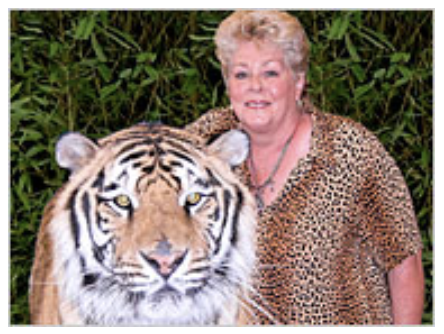
She doesn’t. She loves cats, always has; her uncle trained them in England, and when her horse-trainer father (his act, “Rosaire and Tony the Wonder Horse” made it onto “The Ed Sullivan Show”) branched out, she helped him take Gentle Ben and Clarence, the cross-eyed lion, on publicity jaunts. Clarence walked on a leash and was, she recalls, a couch potato.
Now, Ms. Rosaire rescues lions and tigers the way less adventurous Good Samaritans rescue stray pups and kittens. At last count, she had collected 35 castoffs (some come to her from roadside zoos, some are illegally bred “pets” abandoned by their owners when they get too rambunctious and stop being cute). Ms. Rosaire says there are more big cats in captivity — she once heard about a tiger for sale on the Internet — than in the wild.
Ms. Rosaire, who has trained lions and tigers since 1973 and established her sanctuary 14 years ago, estimates her cats have all been captive for 10 generations. “Nature? They don’t know from it, and they wouldn’t want to be in it. But no person should ever think of getting a big cat as a pet. These cats don’t think of us as food, but when they do hurt you, it’s a bad hurt.”
How often has she been hurt? Just once in 35 years. Tomacura the tiger stalked her from behind and bit her on the hip and leg; Leeds, the aforementioned lion, charged Tomacura and halted the carnage. Ms. Rosaire holds no grudge: “She was testing me and I failed.”
As for Leeds and Tyler, she cries when she mentions their names.
Life is good for Ms. Rosaire’s cats and lions: they consume $100,000 in raw meat a year, are checked by a nutritionist and romp in three swimming pools on their fenced and gated estate.
“I just don’t believe in killing exotic animals,” she says. “We make a commitment to them for life.”
The ones like Leeds and Tyler, those that have a knack for learning “performance behaviors,” formerly known as tricks, go on the road and leap through flaming hoops and whatnot to support the rest of the gang at the sanctuary.
Although Ms. Rosaire and her assistant trainer use whips as a way of defining their personal space, they do their training the humane way: the cats are rewarded with bits of meat on a stick. London broil is a crowd-pleaser.
Raw, not broiled.
Liz Babiarz | The Frederick News-Post | Aug 15, 2003
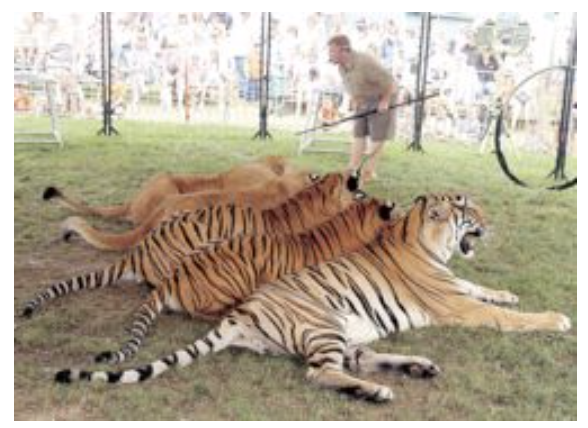
Clayton Rosaire-Mowrey interacts with his lions and tigers at the Big Cat Encounter show at the Montgomery County Agricultural Fair on Thursday. The show has drawn criticism from an animal advocacy group based in Silver Spring.
GAITHERSBURG — An animal rights group condemned the organizers of the Montgomery County Agricultural Fair on Wednesday for hosting an exhibit with caged lions and tigers.
The Fund for Animals, an animal advocacy group based in Silver Spring, took issue with Kay Rosaire’s Big Cat Encounter, which includes three lions and three tigers on display this week at the fair.
“We really feel that wild animals do not belong at the fair,” said Andi Bernat, program director of the Fund for Animals. “They are usually transported in small cages for a long time and spend a lot of time on the road. And, they perform shows for which they receive inhuman training.”
However, fair organizers and exhibitors say no animals are mistreated on the fairgrounds.
“This organization would not condone mistreatment of animals in any way. We would address it right away,” said Randy Fox, executive director of the Montgomery County Agricultural Center Inc., which operates the fair.
“There is no reason to think that there is any mistreatment.”
Mr. Fox said he had not seen any protesters from the group at the fair and the show has received warm praise from the crowds.
Kay Rosaire’s Big Cat Encounter includes three lions and three tigers, performing tricks three times a day with their trainer, Clayton Rosaire-Mowrey, to an audience of awestruck children at the fair this week.
In between shows Thursday afternoon, the lions and tigers slept in cages, which were only slightly longer than their body length but “government approved.” Fans blew on the felines as they lounged.
“Those animal rights people don’t know anything,” said Jim Rosaire-Mowrey, Clayton’s father, who helps with the show. (The family’s real last name is Mowrey, but their show name is Rosaire)
“They say they love animals. I love animals too. I would never mistreat them … I lived in the jungle. I know what these animals need.”
The felines are six of 30 cats that live on a 30-acre sanctuary in Sarasota, Fla., called the “Big Cat Habitat.” Mr. Rosaire-Mowrey, who runs the refuge, said the felines have spacious pens and a beautiful habitat with palm trees as well as swimming pools.
He said most of the cats at the sanctuary originally were strays, rescued from owners who bought the felines without a proper license or realistic expectations. In fact, Mr. Rosaire-Mowrey said they no longer breed the animals and may start taking in other retired circus animals.
When the cats aren’t at their Florida home, they are on tour traveling to fairs, like this one. Mr. Rosaire-Mowrey said the cats are on display for about six months each year, but not continuously. Each fair usually lasts about a week and the group travels about 200 miles to get to the next location.
Mr. Rosaire-Mowrey said the family owns all of their equipment, which allows them to stop and feed the cats frequently during travel.
While the family touted their animal-friendly ways, Ms. Bernat said Kay Rosaire-Mowrey, Clayton’s mother, has been cited for violations by the U.S. Department of Agriculture.
In 1999, Ms. Rosaire-Mowrey worked as a cat exhibitor for the UniverSoul Circus. She was cited by the USDA for failure to provide proper veterinary care and for cage that did not meet minimal size requirements.
Mr. Rosaire-Mowrey said the act is constantly being inspected by the government and some of the requirements are very picky.
“You can get a violation for not having a lid on the saw dust bin,” he said. “Sometimes the regulations are a joke, if you ask me.”
Not only does Ms. Bernat worry about the treatment of these exotic animals, she is concerned fair officials are putting visitors at risk.
“People unfortunately trust that these exotic animals can be domesticated when in fact, the animals often retain their wild instincts,” she said.
According to the Captive Wild Animal Protection Coalition, since 1990, captive tigers killed two children and six adults. About 60 others have been seriously injured, the group said.
Mr. Fox said all the lions and tigers are properly caged and cannot escape to hurt fairgoers.
The Fund for Animals also takes issue with pig racing, another fair attraction.
“It’s just one of those things that exploits animals for people’s entertainment,” said Heidi Prescott, national director of the Fund for Animals. “… It is teaching people that pigs are there to laugh at and entertain them. These animals deserve better than that.”
John Monroe, who owns and operates Barnyard Runners, said his pigs are cared for and treated very well. He has 11 piglets in all, but only four pigs run each race, which last about five minutes.
“When they race, it is play time for them,” Mr. Monroe said. “When they are done, they get washed down and feed. … It is completely safe.”
Pat Rooney, superintendent of the goat exhibit, agreed that no animals are mistreated, even the exotic animals.
“They enjoy those animals and take excellent care of them,” said Mr. Rooney, who used to run a 350-goat dairy.
“Some of these animals cost a lot of money so their owners take good care of them, (they) don’t want anything to happen to them.”
IN PERSON; You Can Call Her A Cat Person
By JILL C. CAPUZZO | The New York Times
July 15, 2001
KAY ROSAIRE is afraid of heights and highway traffic, but put her in a ring surrounded by six snarling tigers and she’s cool as ice.
Wild beasts are second nature to Ms. Rosaire, an eighth-generation animal entertainer who grew up with a celebrity lion, bear and horse. She has spent all her adult life raising and training her own tigers and lions for shows she performs around the country and in Canada. For the last six summers, she has called Clementon Amusement Park home. Each spring she packs up about a dozen of the 22 large cats at her compound in Sarasota, Fla., and drives north to delight audiences with her ”Big Cat Encounter” show here.
Six days a week, Ms. Rosaire steps into the circular, iron-barred ring with an assortment of Siberian, Bengal and white tigers. With the help of her son, Clayton, she gets these animals, which weigh 450 to 700 pounds, to behave like kittens or puppies — rolling over, jumping across one another’s backs, standing up on their haunches. Between stunts, Ms. Rosaire, who calls these cats ”my babies,” pats their noses, scratches them behind the ears and even feeds chunks of raw steak by hand to her largest, and most trustworthy tiger, Conan. The steak serves as an incentive in an act that rejects the old whip and electric prod methods of animal training in favor of rewards of food and kind words.
”I don’t bully them and they don’t bully me,” she said. ”They’re just like kids. You have to reinforce their good behavior with rewards, and when they do something wrong you tell them.”
The British-born Ms. Rosaire, 52, with her long platinum blond mane could be mistaken for one of the pride. While she has no fear — or at least certainly never shows any to the animals — Ms. Rosaire is always cautious around these cats. Her command over animals four times her size is a combination of insight, bluff and peripheral vision, all of which are helped by Clayton, 21, who keeps his eyes peeled from outside the ring. If he sees one of the tigers moving into a stalking position, he alerts his mother, who can then break the action by calling the tiger’s name and commanding it to perform.
But even peripheral vision isn’t always 20-20. Ten years ago, Ms. Rosaire was performing in a circus in a small town outside Quebec when one tiger attacked her from behind and mauled her backside. Her life was saved by a swift slap from one of her performing lions, Leeds, who knocked the tiger away and who Ms. Rosaire now calls her hero. (At 20, Leeds is now retired from the act, but Ms. Rosaire still takes him on the road with her because she feels indebted to him, and besides, she likes having him around.)
The period spent recovering from the mauling, and the 84 stitches it took to put her back together, was the one time Ms. Rosaire doubted her choice of profession.
”It was like getting hit by a car with teeth,” she said. ”I had to ask myself, did I really want to do this anymore.” The scariest part, she said, was going back into the ring with that same tiger 10 days later and wondering if she had lost the upper hand.
Early on it became clear that Ms. Rosaire would follow in the footsteps of her father, Derrick Rosaire, who gained international fame with his television celebrities, Clarence the cross-eyed lion, and Gentle Ben the bear. The Rosaire family first came from England to the United States in 1961 when Mr. Rosaire was offered a gig at Atlantic City’s Steel Pier performing his comedy act, Rosaire and Lenny the Wonder Horse, which continued there for six years. His talented animals earned him four appearances on ”The Ed Sullivan Show” and an invitation to Nixon’s White House.
Kay was not the only Rosaire child to go into the business. Her brother, Derrick Jr., has a bear act, her sister Pamela has a chimpanzee act, and her two other sisters, Linda and Ellian, raise performing horses. The five siblings all live together on a 30-acre compound in Sarasota, along with husbands, ex-husbands (including one of Ms. Rosaire’s two) and offspring.
It was her sister Linda who first introduced Kay to Clementon Amusement Park in Camden County. Linda had been running the petting zoo at this family-run amusement and water park for about 10 years when she mentioned to the park’s owner, Larry Baker, that her sister had a cat act.
”I was looking for something unique,” said Mr. Baker. ”You have your high-dive acts and your porpoise and sea lion shows, but you won’t see a cat show like this at an amusement park anywhere else.”
After visiting her habitat in Florida, Mr. Baker built a similar, smaller, complex at his amusement park, retrofitting the octagonal wooden carousel house to hold the performance ring and adding cages, living space and a sunning and swimming pen in the space where a high-dive act once existed. Between performances, parkgoers can watch the cats playing in the outdoor pen and see the three white tiger cubs Ms. Rosaire recently acquired.
Ms. Rosaire and Mr. Baker together bought the three tigers and will soon try to breed them, but Ms. Rosaire has adopted most of her cats. In general, she takes a hard line against breeding tigers, a practice she encounters everywhere she travels when people come up to her after her show and ask her where they can get a tiger or tell her about the tiger they are raising in their apartments or homes.
”I’ve been offered a lot of money by some people to get them a tiger but I never give them any information,” she said. ”I don’t want the next thing I hear about is how he bit their baby.” Ms. Rosaire has also been offered a number of tigers by owners who tire of them once the cuddly cubs grow up. ”I can’t tell you how many tigers I’ve turned down, and I’m a pretty soft touch.”
In addition to the derring-do, Ms. Rosaire’s show is sprinkled with animal welfare messages. She encourages audiences to adopt pets from animal shelters and discourages those traveling abroad from purchasing tiger parts, which are considered aphrodisiacs, energy boosters or good-luck charms. But this doesn’t stop the occasional challenge from animal rights activists, a group that makes Ms. Rosaire bristle.
”These cats were born in captivity,” she said. ”They couldn’t survive in the wild. Plus, with all the poaching, the tiger born in captivity has twice the average life span as those born in the wild. In Florida I live in a trailer while the cats’ habitat is like a palace. They have a dietician’s plan, a veterinarian plan. I have fans going when it’s hot, and when the temperature drops I’m out here pulling down the tarps and putting blankets on them.”
Ms. Rosaire also believes that being in the ring helps extend her tigers’ lives. She notices a big drop in energy of the cats she eventually retires from the show.
”People think tigers are out running around in the wild, but they’re not,” she said. ”They’re so lazy, they lie around much of the day. Just like people, they need something to do. They get really excited when we’re coming up here because they know they’re coming to perform.”
Five Generations of Circus Acts that Exploit Tigers and Other Big Cats
8/31/17 Leonardo DiCaprio asked to Help Save ‘Wolf of Wall Street’ Co-Star from Rosaires of Big Cat Habitat
You can pretty much tell how much a person has to hide by how many names they operate under. Finding USDA reports on this facility and the Rosaire family has been one of the hardest because they keep changing names, changing locations and changing license numbers. To further exacerbate the situation Rosaire uses a P.O. Box for her USDA entity that houses the big cats making it hard for the average person to find anything on her without knowing her USDA license number. The following is just the beginning of an effort to bring all of their past into one time line to the best of our ability given the lack of government oversite and dismal record keeping.
Perhaps the most perplexing aspect of this research has been how the public can pay to see her forcing the cats to perform and then believe her when she claims that her tigers were rescued. She rescues from herself. They are tigers bred by her for use as props who are then relegated to tiny, barren cages. Most of these only have a tarp for shade. In 2009 she claimed on her USDA renewal to have 18 tigers, 8 lions, 2 leopards, 1 cougar and 1 bobcat as well as an assortment of other exotic animals. If you go to her facility you will see that all of these animals are crammed into a very small patch of her property.
Her inspector is Richard Botehlo who rarely reports anything wrong at her facility. See the whistleblower report filed against USDA by Richard Botehlo below and you will begin to understand why inspectors do not report most of the violations they see.
Photos by Dee DeSantis
Big Cat Awareness Archives
Name That Exploiter
<blockquote=””>
Clayton[son of the founder] is one of the few men in the world who can put his head in a lion’s mouth.
Oh good that’s just what a rescued lion needs.
World-renowned educator and behaviorist Kay Rosaire and her son Clayton present training demonstrations with their rescued big cats in an educational forum.
The above sure looks educational, doesn’t it?
During the demonstrations they gently encourage the cats to show off their magnificent natural behaviors.
Yes that liger looks like he’s being “gently” encouraged. So do these animals,


Our pledge is love, respect and sanctuary for life.
I see so much respect here. It is profoundly tragic to think of an animal being taken from one abusive or exploitative situation, only to be put right in another, and for those people to have the gall to call it a “rescue,” or their facility a “sanctuary.”
On top of this, there is a blatant lack of information on their website about what a liger truly is, as well as what white tigers are. On the page for one of their white tigers, Samson, there is only a lot of praise about how much attention he draws to the facility.
Almost all of the bios for their cats have some excerpt about how they cannot be sponsored or donated to, like this one for their tiger Kira,
Kira instead is one of our best actors who helps raise money for the other animals here at the sanctuary. Therefore, you can not donate to her or sponsor her.
Welp, she’s a performer so we can’t donate. Big Cat Habitat is also a traveling exhibitor, as can be found in all of the same bios for the cats that apparently don’t accept donations or sponsorships:
Kira is at the habitat at different times of the year, but travel a lot, so we can’t guarantee you will see her.
And where do they travel you might ask?
Fairs. What a great sanctuary.
I can’t tell you how many times people confuse Big Cat Rescue with Big Cat Habitat, and to try and compare such an excellent facility with this blatant exploiter is a slap in the face. In Florida hotels, I would often see pamphlets for these two side by side. And it sickened me.
In this video, at about 1:03, you can see a white tiger in a box so people can pose with him.
So please, please don’t ever support this place or confuse it with actual reputable facilities. Big Cat Habitat is nothing but a pseudo sanctuary that does everything they can to exploit their animals for a buck.
bcaarchives Post date: May 13, 2014
USDA Violations
Just because there are not recent violations posted here, it doesn’t mean they aren’t happening. When Trump took office the USDA stopped publishing their reports where the public could see all of the abuse that goes on behind closed gates.
2009 March 19 Rosaire license 58-C-0908 cited for failure to properly identify the dogs and failure to provide proper storage of their food to keep it free of vermin. A dog was being housed in 4.8 square feet of space when the USDA minimum for a dog his size was 6.67 square feet. USDA regulations only require that the animal be able to stand up and turn around in their cages and Rosaire was not meeting even this barest of minimums.
2009 May 19 Pamela and Roger Zoppe have their USDA license 58-C-501 cancelled. Their DBA and address at the time was Rosaire-Zoppe Chimpanzees 5317 Fruitville Road #175 Sarasota, FL 34232
2009 June 22 Pamela and Roger Zoppe pop back up with a new USDA number at the same name and address 58-C-0936
2009 July 7 Rosaire license 58-C-0387 cited for three violations including a freezer that was not working properly where animal food was stored, bears being separated only by use of hot wire where they could reach through and harm each other and bears being kept in such small cages that they could not get out of their own excrement.
2009 October 13 Rosaire license 58-C-0387 cited that a young bear was being kept in a cage where he could not freely stand up and turn around, which is all that the USDA mandates.
2010 June 19 Rosaire license 58-C-0908 cited for one performing dog having an untreated cut above his eye, and 7 dogs being forced to perform in temperatures above 85 degrees (regulation restriction) where the heat index was 107 and one dog was being kept in a cage that only measured 9.69 sf of floor space with USDA regs require 12.25 sf of space. The dog was 3 feet long, so even the minimun requirement was only 3 feet by 4 feet. Rosaire wasn’t even providing the barest minimum of space.
2010 September 25 Rosaire license 58-C-908 cited for a repeat violation of not properly identifying dogs with license tags. The reason USDA regulates this sort of thing is to prevent “bunchers” from stealing dogs and selling them to labs for experimentation.
UniverSoul Circus does not possess an exhibitor license from the U.S. Department of Agriculture (USDA). The animals are leased from outside companies, including Tarzan Zerbini Circus, Carson & Barnes Circus, Kay Rosaire, Bucky Steele, Rosaire-Zoppe Chimps, and Mitchel Kalmanson, so that the pages and pages of cited violations they have incurred are obscured through multiple owners, names and entities.
Rosaire’s Known Licenses and Aliases
Florida 3092 58-C-0387 Rosaire, David David Rosaire’s Perky Pekes P.O. Box 50094 Sarasota 34232 license issued 6/1998
Florida 2998 58-C-0496 Rosaire, Ross Derrick & Kay Rosaires Bears Po Box 346 Myakka City 34251
Florida 9309 58-C-0769 Rosaire, Wayne Rosaires Royal Racers Po Box 338 Bostwick 32007 this is for 14 racing pigs
Florida 3121 58-C-0367 Rosaire-Mowrey, Kay Rosaire-Mowrey Family P O Box 50217 Sarasota 34232 license issued 10/1990
Florida 6648 58-C-0608 Zoppe, Andrea 3074 Myrtle Sarasota 34234 last inspection was in 2008 for 6 dogs
Florida 13162 58-C-0908 Zoppe, Dallas 3115 44th St Sarasota 34234
Florida 3009 58-C-0501 Zoppe, Pamela & Roger Rosaire-Zoppe Chimpanzees Rosaire-Zoppe Chimpanzees Sarasota 34232
Florida 3009 58-C-0936 Zoppe, Pamela & Roger Rosaire-Zoppe Chimpanzees Rosaire-Zoppe Chimpanzees Sarasota 34232
Florida 3175 58-C-0868 Arneberg, James Arnberg Super Dog Show 7101 Palmer Blvd Sarasota 34234 this is the physical address for the tigers
Florida 32030 58-C-0832 Dymek, Kazinerz Party Animals Petting Zoo Llc 901 East Rd Sarasota 34240 SunBiz registered to Rosaire no inspection since 2009
The following are USDA licensees in Sarasota that may or may not be affiliated with Rosaire. These are still being evaluated.
Florida 1874 58-C-0012 Zerbini, Alain Alain Zerbini Circus Production 3327 51st St. Sarasota 34235
Florida 40523 58-C-0886 Svensson, Carlos 7419 Prospect Rd Sarasota 34243
Florida 7398 58-C-0629 Castano, Raul Swap Shop 151 Verna Road Sarasota 34240
Florida 32762 58-C-0905 Creadon, Peggy Pony Parties Of Sarasota 7034 Westwood Dr Sarasota 34241
Florida 3883 58-C-0788 Donoho, Georgina P. O. Box 1418 Sarasota 34230
Florida 38355 58-C-0878 Esqueda, Alfonso Sulo Esqueda Brother Circus 935 N Beneva Rd S609 #43 Sarasota 34232
Florida 38122 58-C-0876 Fornasari, Tosca 3322 Oak Grove Dr Sarasota 34243
Florida 33721 58-C-0845 Garcia, Katherine Star Family Circus 2621 Ridge Ave Sarasota 34235
Florida 18946 58-C-0753 Juchno, James 745 N Pompano Ave Sarasota 34237
Florida 10034 58-C-0664 Klose, Hans & Adele Adeles Canine Review 4600 Sloan Ave Sarasota 34233
Florida 20089 58-C-0852 Markov, Andrey 5136 Indian Mound St Sarasota 34232
Florida 31471 58-C-0841 Maya Panfilova, Andriy Bilobrov & 2250 Gulf Gate Dr Suite A Sarasota 34231
More on Kay Rosaire http://reporter.911animalabuse.com/service/searchEverything.kickAction?keywords=rosaire&includeVideo=on&includeAudio=on&includePhoto=on&includeBlog=on&includeUser=on&includeGroups=on&includeMessages=on&includeSets=on&as=23072&sortType=relevance
Kay Rosaire and her son Clay Rosaire do not rescue cats, but rather are a part of the problem rather than the solution. They do not walk the talk and these pages will tell you more about them:
http://reporter.911animalabuse.com /kickapps/service/searchEverything.kickAction?keyw ords= rosaire&includeVideo=on& amp;includeAudio=on&includePhoto=on&includ eBlog=on&includeUser=on&includeGroups=on&a mp;includeMessages=on&as=23072
This is nothing more than an antiquated “carnie” circus.
Thankfully, in this more enlightened age of animal compassion, the market for these animal abusive displays is dwindling. Most people realize that there is nothing “educational” about seeing infant or adultwild animals caged, transported from venue to venue, “tamed” using abusive methods, existing solely as a profit center for a business.They watch Animal Planet, they visit truly accredited rescue sanctuaries, they are more aware of the reality of life for these imprisoned animals. In short, they are more educated and will look at anyone promoting them as irresponsible. (please note below the negative publicity that fairs have received as a result of displaying captive wildlife from leased organizations and the truth behind these displays)
Kay Rosaire ‘s organization is not accredited and has been cited by the government for the abusive conditions in which their animals are kept. At a USDA Big Cat Symposium in Fort Worth, Texas on March 26, 2003, Kay Rosaire made this statement on stage: “To keep a tiger off you, you just poke ’em real hard with a pitchfork a time or two and show ’em who’s boss. Then they’ll get the message.”
These two articles will give you background on what the Rosaire ‘s are really about.
http://www.bigcatrescue.org/ s/0articlesbybcr/2008DyingToBeHeld.htm
http://www.bigcatrescue.org/circus tigers.htm
http://www.bigcatrescue.org/ s/0articlesbybcr/claws_and_effect.htm
The animals have no voice, but you do, and you can still do so much to put an end to their abuse.
USDA Whistle Blower Report
January 5, 2005
Richard Botelho Jr, Animal Care Inspector for the United States Department of Agriculture, Animal Plant Heath Inspection Service, Animal Care agency, has filed a whistle blower complaint against USDA with the US government “Office of Special Counsel,” dated January 4, 2005.
As an animal care inspector and citizen of the United States, Richard Botelho Jr, believes the public needs to be aware of the prohibited practices by the Animal Care’s management at the eastern regional office. The OSC whistle blower complaint alleges multiple violations of federal regulations and law, gross mismanagement and waste of funds at Animal Care’s eastern regional office in Raleigh, NC.
The Animal Care agency is responsible for enforcing the Animal Welfare Act, which is federal legislation that ensures the humane care and treatment of certain warm blooded and exotic/wild animals. Animal Care conducts routine inspections at facilities that use regulated animals in research, exhibited to the public, sold wholesale and retail and transported. Licensed facilities would include but are not limited to zoos, circuses, wholesale dog / cat breeders, exhibitors, exotic / wild animal dealers and exhibitors to include transporters. Animal Care’s Mission Statement: AC provides leadership in establishing acceptable standards of humane animal care and treatment and to monitor and achieve compliance with the Animal Welfare Act through inspections, education, and cooperative efforts. Unfortunately, records show in the last several years Animal Care in the eastern region has failed to use enforcement to achieve compliance.
This lack of enforcement has caused more prolonged health and welfare problems for animals that AC is required to protect by the federal Animal Welfare Act. The lack of enforcement has also caused more incidents with potentially dangerous animals and the public. Animal Care in the eastern region is failing to enforce the Animal Welfare Act, which is endangering the animals we are responsible to protect to ensure adequate care and treatment. Failing to enforce the minimum standards and regulations of the AWA, has harmful risks to the animals and to the public. Potentially dangerous animal are being allowed to be exhibited to the public without direct control of a handler(s), sufficient distance or barrier between the animals and the public.
The OSC complaint states the Eastern Regional Office allows licensee’s with a history of repeat noncompliance’s to operate without any legal action against such licensees. Evidence shows that Animal Care paid consultation fees to a licensee to consult with a facility which had a history of repeat noncompliance’s. Repeat violators of the AWA are seldom given warnings. When legal action is taken against violators, only a fraction of the proposed fine is given by a stipulation agreement. The licensee does not have to admit to the history of repeated violations when they accept a stipulation agreement.. Even when the investigation shows the licensee has repeatedly violated the AWA, which affected the health and welfare of the animals and or public, Animal Care issues a warning or small stipulation. Facilities often accept these stipulations and continue to violate the AWA minimum standards and regulations year after year, stating it’s just the cost of doing business. Even after facilities pay multiple stipulations they continue to violate the AWA without any further action by Animal Care. USDA licenses are rarely revoked and commonly renewed, even when facilities have a history multiple repeat violations and not in compliance. Research facilities pay thousands of dollars in stipulations which usually cost the taxpayers, because the research with animals is mainly funded by the US government.
Inspectors request warning letters and investigations for repeat violators of the AWA from Animal Care management, never toreceive such requests, and without any reply to the inspector. There are several lawsuits against Animal Care from animal welfare groups for allegedly failing to enforce the Animal Welfare Act, which may cost the taxpayers thousand of dollars in attorney and settlement fees. The eastern regional office has issued far less warning letters and stipulations than the western regional office. Recently there was an audit by USDA, Office of Inspector General of the eastern regional office, due to the lack of enforcement issued to facilities. This audit should now be available by FOIA.
The whistle blower complaint states the eastern regional office superiors hire inspectors in areas which are fully staffed. Inspectors with a lack of facilities and work are often sent to other inspectors facilities and paid for travel and lodging. Yet, other inspectors,with over a hundred facilities more than other inspectors, which have not inspected facilities for several years, are not given additional inspectors for their territories.
The OSC complaint states Inspectors are often approved to visit other cities and states, just to visit relatives or site see, as long as they conduct inspections in that requested territory. These visits are paid by Animal Care, the taxpayers dollars. In most circumstances the inspector assigned to that territory has never requested any additional help from his or her superior.
The whistle blower complaint states the eastern regional office of Animal Care purchases laptop computers, digital cameras, and other equipment when the current inventory are in excellent working condition. Unnecessary purchases are made before the end of the fiscal year to spend what monies are left in Animal Care’s budget.
The OSC complaint states inspectors were verbally reprimanded and their complaints not heard by Animal Care management when they refused to join coworkers at a training course at Plum Island, New York, where animals were given a variety of diseases without pain management before their death. Animal Care enforces pain management at research facilities, however USDA fails to follow such standards during its own training programs.
The whistle blower complaint states an inspector alleges that Animal Care management gave direct orders to an inspector to expunge files which were FOIA from a federal agency due to an investigation of a human death at a research facility. Other requested records from USDA, FOIA, have taken over 2 years and requesters still have not received the FOIA nor the reason for the delay.
Inspector Botelho has been inspecting facilities for nearly 5 years in SW Florida. He has conducted an astounding number of inspection, nearly 1000 inspections which have uncovered over 200 persons operating without a USDA license, some for many years. He has been given all successful evaluations each year, has no prior discipline, and has an exceptional sick leave record.
Unfortunately, since Animal Care inspector Botelho has complained about the gross mismanagement in the last several years and filed numerous complaints against his supervisor and Director of the eastern regional office, he has been retaliated against recently to include one 14 day suspension unpaid for alleged improper conduct.
Five days after serving his first suspension, he was issued a proposed 14 day suspension unpaid for alleged improper conduct. The improper conduct Director for investigations division for RMSES, stated inspector Botelho used profanity during a telephone conversation. The telephone conversation was a complaint by inspector Botelho due to RMSES investigators calling his home during late hours, harassing his family and waking his children.. Inspector Botelho’s first suspension states that he had 5 complaints against him for alleged inappropriate conduct from USDA licensees who have repeatedly violated the Animal Welfare Act and was issued either warning or stipulations. It appears that 5 complaints, which were here say, out of 1000 inspections is a very high percentage by Animal Care standards.
The eastern regional office Director has not disciplined inspectors with greater number of complaints initiated against them, to include Ethics violations (conflict of interest accepting gifts from licensees) AC management does not support their inspectors, but supports high profile licensees when complaints are initiated against them, especially if such facilities threaten lawsuits against the agency. There is a complaint procedure for licensees, however none for inspectors who often learn of complaints during an internal investigations or suspensions.
Management has unlimited funds for legal fees. Yes, their USDA attorney is provided free of charge for their gross mismanagement at the cost of the tax payers. There is seldom any accountability when government superiors are found guilty of discrimination or retaliation, except for future promotions. There is a free in-house grievance procedure for Animal Care employees, but it is evident that the decision would not be UN-bias, due to being made by the USDA administrator. Inspector Botleho has hired an out of state employment attorney in the last several months, which he has since paid over thousands of dollars in legal funds. It has been over two years since inspector Botelho filed initial complaints against USDA, APHIS, Animal Care. The US government being back logged with complaints and lack of staff has yet to set a hearing with a federal judge at the EEOC.
Congress needs to help federal employees do their job with dignity and respect, allowing them to file complaints in a timely and cost effective manner. Help is greatly needed for employees who file complaints against their superiors, due to the cost and time it takes for employees to receive their justice. Federal managers are allowed to issue discipline without pay and state that employees are guilty before employees can prove their innocence, costing thousands of dollars to them and their families. Most employees in inspector Botelho’s situation give into management and drop their complaint because of retaliation and the lack of funds for legal representation. Since inspectors fear complaints against them and do not get support from the management, most end up picking their battles at certain facilities, turning their heads from citing enforcement resulting in poor work ethics. Other federal employees are given ultimatums to resign or be fired. Federal managers need to be accountable for their gross mismanagement. History shows that employees who file whistle blowers eventually will be wrongfully terminated, hopefully history don’t repeat itself for inspector Botelho and congress will make some serious much needed changes in current federal regulations and laws.
Before Inspector Botelho filed this whistle blower complaint with the Office of Special Counsel, he has recently forwarded such similar complaints to his chain of command to include: Deputy Administrator, Dr. Chester Gipson, APHIS Administrator, Dr. Ron Dehaven, Ann Venneman, USDA Secretary of Agriculture, Agriculture Committee, Governor of Florida, Jeb Bush and President George Bush.
Hopefully his concerns and complaints will be heard by all animal lovers worldwide for the health and welfare of the animals regulated by USDA, APHIS, Animal Care. Animal Care inspectors need to be supported to enforce the Animal Welfare Act. Repeat violators of the AWA need to be issued the appropriate legal action by Animal Care management.
Inspector Botelho can be reached by e-mail at: critermanfl40@wmconnect.com .
Kay Rosaire takes her circus act to Bermuda and the cats on barges
Animals from non-profit sanctuary (read pseudo sanctuary)
By Ruth O Kelly-Lynch
Tigers and bears from a non-profit sanctuary will arrive on the Island for the Animal Extravaganza shows which begin on May 26.
The animals are coming from Big Cat Habitat and Gulf Coast Sanctuary in Florida. DNA Entertainment spokesman Ray Hollis said the company would be bringing six tigers and five bears. The sanctuary, run by Kay Rosaire, has been rescuing exotic animals from unhealthy environments since 1987.
Approximately 57 large cats call the sanctuary home at the moment. They live on three large indoor/outdoor complexes with swimming pools, toys and trees. The brochure says the activities provide emotional enrichment that maintains optimal mental and physical health.
Ms Rosaire and her son hold educational shows and demonstrations in order to raise funds for the habitat. Their brochure touts them as gentle caregivers:
Their unique style of gentle handling, praise and treats encourage the natural behaviours of big cats on cue and in a sequence of their choice. Clayton is one of the few men in the world who can put his head in a lions mouth. Semi-retired from the entertainment industry, Kay dedicates herself full time to the rescue of big cats and other animals in need of a safe, permanent home, and continues to the educate visitors at the Big Cat Habitat and Gulf Coast Sanctuary as to the plight of these magnificent animals in the wild, addressing subjects such as conservation and habitat preservation. Kay has spoken at two big cat symposiums for the United States Department of Agriculture and is a recognised expert in animal husbandry pertaining to lions and tigers.
The Society for the Prevention of Cruelty to Animals is currently investigating the group to ensure that it treats the animals well. Teresa Ince, Shelter Manager, said the Society still has concerns about the event.
We are still not endorsing the event because we are concerned about the transport of the animals, the veterinary care and the housing of the animals while they are in Bermuda and their safety, she said.
Mr. Hollis said he was aware that the SPCA would probably not be endorsing his event, though he said he has not made any contact with them recently. Even if you have the best trainers and safety in place it will not change their stance, he said. They do not want them in cages so what can you do? That is their opinion.
He said that the SPCAs concerns have not hurt ticket sales to the event, they have already sold out of all $25 tickets to the four shows. There are still $35 and $40 tickets to the shows which will be held May 26-28.
The public seems to realise that with any animal you have to transport them in a cage, he said.
The animals will arrive on the Island on May 21 via a freight ship. He is currently in discussions over where to keep them while they are on the Island. A spokesman from the Environment Ministry said it had not granted DNA Entertainment permission to import the animals and the Ministry is still actively reviewing the case.
Mr. Hollis said it is not customary to apply for permission until ten days before the event and added that he is in constant touch with the Ministry. He also said his company has not been affected by North Rock Communications pulling its sponsorship from the event.
I respect their decision, he said.
He added that he is looking to include local animal acts into the Animal Extravaganza as well as the big cats from the sanctuary.
http://www.theroyalgazette.com/apps/pbcs.dll/article?AID=/20060504/NEWS/105040119
MONTGOMERY COUNTY NOT FAIR TO LIONS AND TIGERS
Fund for Animals Condemns Agricultural Fair for Hosting Big Cat Encounter
SILVER SPRING, MD (August 14, 2003)
The Fund for Animals is condemning the organizers of the Montgomery County Agricultural Fair for allowing the exhibit of lions and tigers by Rosaires Big Cat Encounter. Five lions and three tigers confined to small cages are on display at the fair this week.
The fair is taking a huge risk by promoting captive wild animal shows such as this, said Andi Bernat, Program Coordinator for The Fund for Animals. People unfortunately trust that these exotic animals can be domesticated when in fact, the animals often retain their wild instincts. According to the Captive Wild Animal Protection Coalition, captive wild cats exhibited to the public have been responsible for 8 deaths and over 60 injuries. Bernat also pointed out that people who are in the business of displaying captive wild animals often end up selling or trading their animals to circuses, roadside petting zoos, and trophy hunting ranches.
In fact, Kay Rosaire , one of the Big Cat Encounter owners, was an exhibitor for UniverSoul Circus, which has been cited for a number of infractions including Animal Welfare Act violations, said Bernat. In 1999, the Big Cat Encounter was cited by the USDA for failure to provide proper veterinary care and for cages that did not meet minimal size requirements.
Captive wild animals deserve to be treated as animals, not as stage props, said Bernat. Having lions and tigers at a county fair is not only inhumane to the animals, but also poses a danger to citizens and could make the county and the fair organizers liable for injuries ordeaths.
In March of 2012 the Rosaire Circus dragged their cats up to the IX Indoor Amusement Park in Cleveland, OH for the third year in a row.
FACTS YOU SHOULD KNOW BEFORE ALLOWING WILD ANIMAL DISPLAYS
In an attempt to clean up the sleazy image long associated with roadside zoos, operators of these facilities now declare themselves “conservationists.” They in fact do nothing to protect wildlife or preserve habitat, and they breed animals indiscriminately, without regard for genetic diversity and with nowhere suitable for them to go. What people learn from these exhibitors is how animals act in captivity and that it is acceptable to cause wild animals to be bored, cramped, lonely, and kept far from their natural homes.
Profit-hungry operators perpetually breed animals so that they will have an endless supply of “cute babies” in order to draw crowds. The older, unmanageable animals are left to languish in small cages or disposed of when they have exhausted their “usefulness.” Exotic animal auctions, frequented by unscrupulous dealers, are a popular method of discarding unwanted “display” animals, who ultimately end up in the pet trade, on breeding farms, killed for their skins and other organs, or used for canned hunts. Some animals, such as tigers, lions, and bears—both cubs and adults—are worth more dead than alive. Hides alone can fetch $2,000 to $20,000 or more. Entire families are slaughtered and stuffed for mounts that sell for $10,000. To avoid damaging pelts, animals are killed by the most gruesome methods imaginable, such as shoving ice picks through their ears and into their brains, suffocating them by wrapping plastic bags around their heads, and drowning.
Wildlife exhibitors mislead the public with impressive-sounding but meaningless credentials, such as “federally licensed by the U.S. Department of Agriculture (USDA) and U.S. Department of the Interior.” Federal permits to exhibit, breed, or sell regulated animals are required and issued to nearly anyone who fills out an application and sends in a fee. The USDA exhibitor application is a 3/4-page-long form that asks for a person’s name, address, and animal inventory but nothing that pertains to qualifications. The Animal Welfare Act, which the USDA enforces, sets only minimum standards of care and rarely addresses an animal’s psychological needs. The U.S. Fish & Wildlife Service (USFWS), the branch of the Department of the Interior that issues permits to buy and sell threatened and endangered species, considers non-native wildlife a low priority. Breeding mills have so saturated the market with “generic tigers” of unknown lineage that USFWS exempts these animals from full regulation. Some exhibitors even retain their licenses despite incidents of deadly animal attacks, dangerous animal escapes, serious violations of the Animal Welfare Act, and illegal wildlife trafficking.
Circuses: Clean Family Fun Or Havens Of Cruelty?
This video is 23 minutes long, so it takes a few minutes to load.
If this video makes you mad, then DO SOMETHING about it!
Send a letter to your legislator with our quick & easy form at www.CatLaws.com
The Best Response to Circuses Ever Written
By Kerry Ashmore , The Northeaster
Numerous thorny issues cloud the debate over how humans treat animals. One issue coming quickly to Minneapolis, however, has a clear and easy correct answer. We urge Minneapolis City Council members to ban wild animal circus performances in the city.
This will not require all of us to become vegetarians. It won’t ban laboratory research. It won’t be a death sentence for any animal that bites a human. Minneapolis taxpayers would simply be refusing to allow people to make money in the city through capturing and training wild animals, and would be foregoing any money the city and local businesses might make if the circus came to town.
This issue is similar to some other thorny issues, however, in that many people will oppose the ban because they don’t want to believe that circuses are necessarily cruel to animals. To support the ban, they would have to admit that the whole concept of capturing and
training wild animals for human entertainment and enrichment is, and always has been, wrong; and that they have been wrong for not doing everything they could to ban the practice decades ago. Who wants to admit to something like that?
Our advice to them: Deal with it.
Yes, we humans have been wrong all along, and this is a baby step toward making things right.
Those who don’t want the ban will be quick to point to violent and illegal acts people have committed in the name of ending animal cruelty, and suggest that seeking to end animal cruelty somehow indicates that one condones such acts. That simply doesn’t pass the common sense test, and those who bring such incidents into the discussion are essentially admitting that they can’t come up with a reasonable defense for the way animals are treated in a circus setting. This shouldn’t come as a surprise, because there is no reasonable defense for it.
Some local people will lose some money if the ban is passed. Circus people stay in local hotels, eat in local restaurants and spend money in local stores. Our wise and resourceful officials can replace the circus with other events that don’t cause us to support unconscionable acts toward beings who, because of human intervention, are no longer able to defend themselves.
Humans, with complete freedom of movement and superior reasoning capability, grow weary of “life on the road,” and with good reason. Circus animals are caged and moved from town to town, forced to perform unnatural acts and then caged and moved to yet another town for yet another performance. The best efforts of the most kind- hearted people in the world cannot make this process humane. It is
cruel by its nature.
It’s unlikely that the circus people think that what they’re doing is inhumane. It’s only when city after city after city closes its doors that they will ask, “Why?” and perhaps begin to have second thoughts about the way animals have to be treated if they are to provide money- making entertainment to humans.
When and if our society becomes truly civilized, such entertainment will be banned entirely. Those animal-protection laws don’t exist now, and there isn’t a legal way to stop circus use of animals.
Minneapolis, however, has a chance to take one simple, straightforward action, and become the 29th American city to close its doors to wild animal circuses. It’s an action Minneapolis council members should take without delay, without regret and without dissent.
Posted: Wed, 08/01/2007
http://www.tcdailyplanet.net/node/5895
For the love of animals, avoid the circus
By DUNCAN STRAUSS
Special to The Post
Sunday, December 23, 2007
On Wednesday, the Ringling Bros. and Barnum & Bailey Circus lumbers into the South Florida Fairgrounds Expo Center in Palm Beach County for 12 performances. To those considering stepping into the big top to attend one of these shows, I offer this polite request:
Please don’t.
Who am I – some animal-hating killjoy out to spoil your fun? Far from it. I’m a father, a pretty passionate animal lover and, not coincidentally, I host a radio program about animals that airs on Tampa National Public Radio affiliate WMNF.
I do not claim to be a renowned animal expert. But over the years, I’ve done a great deal of research into an array of animal matters. In hosting the show, I’ve had the good fortune to interview a number of renowned animal experts, experiences that have yielded one indisputable conclusion:
Animals in circuses endure a relentlessly awful life, marked by constant travel in cramped quarters, where access to food and water and proper veterinary care can’t always be counted on, but punishment, pain, cruelty and, sometimes, premature death can be.
Hyperbole? Hardly. Any unit of Ringling Bros. is on the road for six to 11 months at a time, typically traveling in small train cars or trucks that are often poorly ventilated and/or lack basic creature comforts.
But the travails of transportation practically seem glorious alongside the covert and overt cruelty of the training that prepares – if that’s the right word – these animals to perform in “the greatest show on Earth.” Allow me to pose two related rhetorical questions:
Do you think that tigers – who, like most animals, are deathly afraid of fire – would be naturally inclined to jump through a ring of fire?
Do you think that elephants would be naturally inclined to balance on a colorful perch, stand on their hind legs or heads, or dance?
The answer, of course, is a resounding “No.” So, to achieve the sort of unnatural and physically challenging behaviors described above and others, the training is fear-driven, revolving around punishing and hurting the animals: whipping them, beating them with rods, etc.
Elephants often are restrained, then beaten until they understand not to fight back. The chief tool of the elephant training trade is the bull hook, or ankus, which is heavy and clublike and has a pointy, sharp tip. Imagine a heavy and sharp fireplace poker. The trainers hit the elephants with the bull hook in various parts of their body, so that they comply – “learn.”
Sounds too horrendous to believe, doesn’t it? But there is plenty of testimony by former Ringling employees that says as much, and lots of video that shows as much – some of it as new as this year. To see an extensive array of germane video footage in less than eight minutes, you could hardly do better than watching the award-winning piece on Ringling and its abuse of Asian elephants by television journalist Leslie Griffith, who has won nine local Emmys and two Edward R. Murrow Awards, It’s at www.youtube.com/watch?v=I3rQzLOLR4M.
Keen observers of Ms. Griffith’s work will notice that it’s from 2004, and might reasonably wonder whether Ringling has improved its treatment of animals. Nope. In October 2006, Robert Tom, a former animal keeper who worked for Ringling for nearly two years (his wife, Margaret, also was employed by the circus) issued a notarized declaration – six pages of hair-raising accounts of animal neglect, abuse and cruelty in and around the big top.
Mr. Tom’s experiences echo those of Archele Faye Hundley, a young mother of five, who worked as part of the animal crew. Her lengthy September 2006 notarized declaration, notes: “I quit the circus because the animal abuse was too upsetting. The abuse was not once in awhile, it occurred every day.”
The American Society for the Prevention of Cruelty to Animals, along with three other not-for-profit animal welfare organizations – The Fund For Animals, Animal Welfare Institute and Animal Protection Institute – are in the midst of litigation, under the Federal Endangered Species Act, against Ringling. The allegations detail the routine abuse and neglect of Asian elephants. The groups are joined in the lawsuit by a former Ringling employee, Tom Rider, who worked as a barn man for the elephants for 21/2 years, and is featured in the Griffith piece.
I digress here briefly for a prediction: Ringling owner Kenneth Feld surely will dispatch someone to respond to this piece – could be an official employee or maybe someone in the guise of a Ringling fan writing a letter to the editor – to dismiss these contentions as the ravings of a misinformed loon.
There will be rosy scenarios offered about their training, about their “conservation efforts” (their Center for Elephant Conservation is little more than a facility to restock the touring units with fresh pachyderms), about how great their animals are treated, etc. There are millions of dollars at stake, and elephants are the prime drawing cards, so when someone is critical of the operation, Mr. Feld and his fellow Ringling panjandrums typically mobilize quickly. And they’ll say anything
Nonetheless, let’s just say, for the sake of ludicrous argument, that nothing untoward is visited on elephants in the course of their big top training. They’re still forced to travel in those train cars or trucks to perform up to three shows a day and to spend most of their non-performance time anchored by leg chains.
Let me hasten to add that I’m not at all universally opposed to circuses, just those that use animals. There are numerous animal-free circuses – perhaps the most famous is Cirque du Soleil, but the last list I saw featured more than 20 such outfits.
If your family has a hankering to see a circus, go to one of those. But attending a Ringling performance is tantamount to endorsing animal abuse.
Read it online HERE
Nov 18, 2011 News Reports Woman Posing and Petting Over Age Cub at Big Cat Habitat in Sarasota owned by Kay Rosaire:
By: CliffRoles http://spotted.heraldtribune.com/photos/index.php?id=2465158
</blockquote=””>


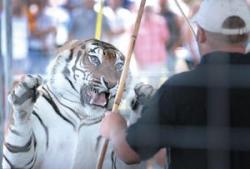
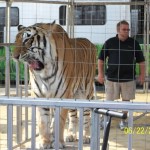
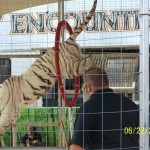
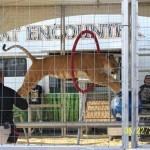
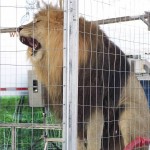

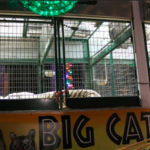
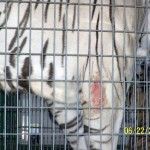
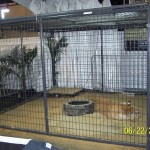
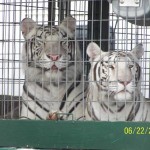
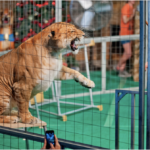
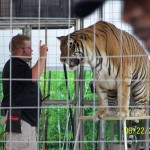

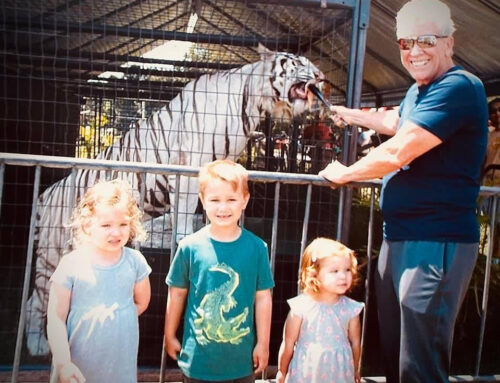
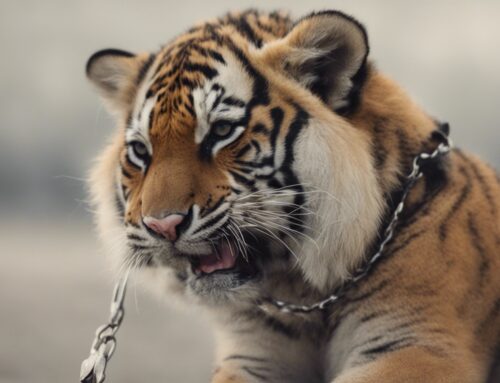

Thank you for this information, I have written a letter and will cross post to every one I know.
Why are these people wasting their whole lives treating these majestic WILD animals like pieces of toys? NO amount of money is worth this cruelty and inhumanity.
PLEASE let these Big Cats go to the Habitat where they can live out their lives in Peace and Privacy!